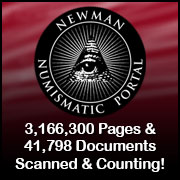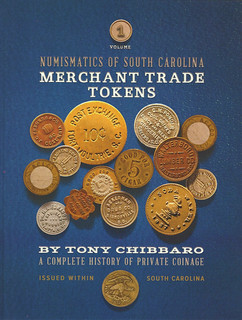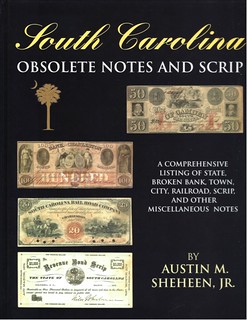
About UsThe Numismatic Bibliomania Society is a non-profit association devoted to the study and enjoyment of numismatic literature. For more information please see our web site at coinbooks.org SubscriptionsThose wishing to become new E-Sylum subscribers (or wishing to Unsubscribe) can go to the following web page link MembershipThere is a membership application available on the web site Membership Application To join, print the application and return it with your check to the address printed on the application. Print/Digital membership is $40 to addresses in the U.S., and $60 elsewhere. A digital-only membership is available for $25. For those without web access, write to: Charles Heck, Treasurer AsylumFor Asylum mailing address changes and other membership questions, contact Chuck at this email address: treasurer@coinbooks.org SubmissionsTo submit items for publication in The E-Sylum, write to the Editor at this address: whomren@gmail.com
BUY THE BOOK BEFORE THE COIN |
- WAYNE'S WORDS: THE E-SYLUM OCTOBER 18, 2020
- KOLBE & FANNING SALE #157 THIS SATURDAY
- CHARLES DAVIS DECEMBER 2020 SALE SELECTIONS
- REINER SEUPEL ISLAMIC NUMISMATIC LITERATURE SALE
- NEW BOOK: SOUTH CAROLINA MERCHANT TRADE TOKENS
- REVIEW: ANCIENT COINS IN EARLY AMERICAN AUCTIONS
- WHITMAN ENCYCLOPEDIA OF COLONIAL COINS
- AUSTIN M. SHEHEEN, JR. (1934-2020)
- JOEL R. ANDERSON (1944-2020)
- NEWMAN PORTAL: FIRST HALF EAGLE STRUCK IN 1795
- VIDEO: DENVER COIN EXPO DURING COVID VIRUS
- P.O. TREMBLAY CORRESPONDENCE DIGITIZED
- COLONIAL COIN COLLECTORS 2020 VIRTUAL CONVENTION
- DASSIER'S KINGS AND QUEENS OF ENGLAND MEDALS
- NOTES FROM E-SYLUM READERS: OCTOBER 18, 2020
- COINHUNTING IN SPANISH FLEAMARKETS
- EDWIN JOHNSTON'S AI MONEY ART DESIGNS
- VOCABULARY TERM: PRIVATE MINT
- CHARLES GRAY (1696-1782)
- THE PAN FALL 2020 SHOW WILL TAKE PLACE!
- CAND CANCELS 2021 CONVENTION
- STEPHEN ALBUM RARE COINS AUCTION 38 RESULTS
- GOLDBERG AUCTIONS SOFAER PALESTINIAN RESULTS
- ARCHIVES INTERNATIONAL AUCTION 62
- COLTRANE COLLECTION SELECTIONS: BACK DESIGNS
- NUMISMATIC NUGGETS: OCTOBER 18, 2020
- ANCIENT LIMESTONE TWO SHEKEL WEIGHT
- DAVID VAGI GOLD IDES OF MARCH COIN INTERVIEW
- MEDIEVAL KILWA COINS DISCOVERED IN AUSTRALIA
- ARTIST CREATES QATAR DEMONSTRATION DESIGNS
- CHRISTOPHER COLUMBUS: HIS DECLINE IN NUMISMATICS
- MAURICE STORCK FRACTIONAL GOLD COINS
- SAFE DEPOSIT COLONIAL PAPER COLLECTION RETURNED
- GREENWOOD BANK FOR UNDERSERVED COMMUNITIES
- LOOSE CHANGE: OCTOBER 18, 2020
- THE LAST BOOKSTORE
- GOLD SMUGGLER CAUGHT AT INDIAN AIRPORT
Click here to access the complete archive
Click here to unsubscribe (scroll down)
To comment or submit articles, reply to whomren@gmail.com
Content presented in The E-Sylum is not necessarily researched or independently fact-checked, and views expressed do not necessarily represent those of the Numismatic Bibliomania Society.
WAYNE'S WORDS: THE E-SYLUM OCTOBER 18, 2020
 New subscribers this week include:
Walter J. de Lorrell, Jr., courtesy of Ken Berger;
Miss Christian Baeza-Anaya (Guadalajara, Jalisco) and
Dr. Luis Gómez-Wulscher (Mexico City), courtesy Adrián González-Salinas;
Joey Lamonte,
John Van Vranken,
Michael Louis Javick and
Stephen Olson.
Welcome aboard! We now have 6,570 subscribers.
New subscribers this week include:
Walter J. de Lorrell, Jr., courtesy of Ken Berger;
Miss Christian Baeza-Anaya (Guadalajara, Jalisco) and
Dr. Luis Gómez-Wulscher (Mexico City), courtesy Adrián González-Salinas;
Joey Lamonte,
John Van Vranken,
Michael Louis Javick and
Stephen Olson.
Welcome aboard! We now have 6,570 subscribers.
Thank you for reading The E-Sylum. If you enjoy it, please send me the email addresses of friends you think may enjoy it as well and I'll send them a subscription. Contact me at whomren@gmail.com anytime regarding your subscription, or questions, comments or suggestions about our content.
This week we open with three numismatic literature sales, one new book, a review, two remembrances, updates from the Newman Numismatic Portal, and more.
Other topics this week include South Carolina tokens, ancient coins, colonial American coins, coin shows, fleamarket coinhunting, money art, private mints, auction results and upcoming sales, Christopher Columbus in numismatics, California fractional gold, and The Last Bookstore.
To learn more about the P. Scott Rubin Library, Newcomb's United States Copper Cents 1816-1857, Thomas Elder's collection of silver coins of Alexander the Great, paper money dealer Austin Sheheen, collector and hobby supporter Joel R. Anderson, the first Half Eagle, medals of the kings of England, the Heaton Mint, Templar Tokens, William Kneass, the Will Page medal, macerated currency postcards and reverse ATMs, read on. Have a great week, everyone!
Wayne Homren
Editor, The E-Sylum
KOLBE & FANNING SALE #157 THIS SATURDAY
REMINDER! The Kolbe & Fanning P. Scott Rubin Library sale closes Saturday, October 24, 2020. -Editor
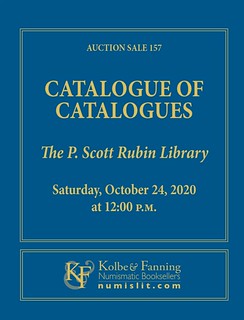 KOLBE & FANNING SALE THIS SATURDAY
KOLBE & FANNING SALE THIS SATURDAY
Kolbe & Fanning Numismatic Booksellers are offering the P. Scott Rubin Library for sale by auction this Saturday, October 24, 2020, beginning at 12:00 noon eastern time. The auction features Rubin's extraordinary library of American numismatic auction catalogues published between 1851 and 2020, and covers the spectrum of numismatic topics. The sale may be viewed at bid.numislit.com.
Bids may be placed via post, email, fax or phone, as well as online. Bids placed via post, email, fax or phone must be received by Friday, October 23, the day before the sale, in order for them to be processed. Kolbe & Fanning uses Auction Mobility as our third-party online bidding platform. Auction Mobility is an app-based platform allowing users the ability to participate in the sale through phones, tablets and computers. To register for the sale, bidders must go to bid.numislit.com and sign up. Once you have set up an account, you may browse lots, place advance bids, or participate in the live sale online. Please note that as this is a third-party site, your login information for the main K&F site will not work for the auction site: you need to establish a separate account. Those wishing to participate on their devices can download the Kolbe & Fanning app through the Apple or Google Play Store.
Advance absentee bids may also be placed online at bid.numislit.com; live internet bidding will be available during the sale itself through the same platform. Bidders placing absentee bids will be able to tell immediately whether or not they have the current high bid. Bidders will also receive email notifications when they are outbid before the sale (users of the app may opt to receive push notifications as well).
Kolbe & Fanning Numismatic Booksellers LLC is a licensed and bonded auction firm in the State of Ohio. For more information, please see the Kolbe & Fanning website at numislit.com or email David Fanning at df@numislit.com. To register for the sale, go to bid.numislit.com. We look forward to your participation on October 24.
To read the earlier E-Sylum articles, see:
NOTES FROM E-SYLUM READERS: SEPTEMBER 27, 2020 : Rubin's "Catalogue of Catalogues"
(https://www.coinbooks.org/v23/esylum_v23n39a13.html)
KOLBE-FANNING AUCTION SALE 157 ANNOUNCED
(https://www.coinbooks.org/v23/esylum_v23n40a02.html)
KOLBE & FANNING'S "CATALOGUE OF CATALOGUES" SALE
(https://www.coinbooks.org/v23/esylum_v23n41a04.html)
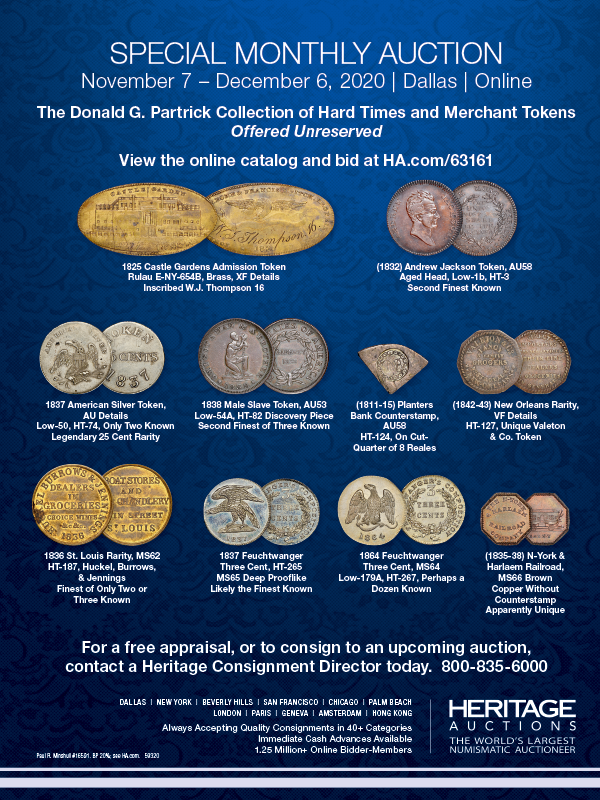
CHARLES DAVIS DECEMBER 2020 SALE SELECTIONS
Charlie Davis submitted this note with some highlights of his next numismatic literature sale. Thanks. Great material! -Editor
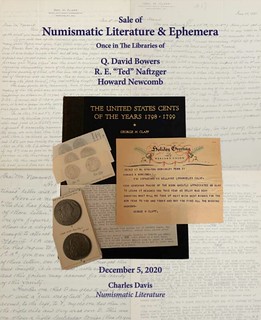 Our December 5 auction sale of literature and ephemera will include many unique items. Posted on our site
Numisbook.com is the full catalogue and photos of each lot. Of interest to large cent aficionados will be books owned by Howard Newcomb and Ted Naftzger.
Our December 5 auction sale of literature and ephemera will include many unique items. Posted on our site
Numisbook.com is the full catalogue and photos of each lot. Of interest to large cent aficionados will be books owned by Howard Newcomb and Ted Naftzger.
Shown below are Ted's very heavily annotated copy of Newcomb's 1944 United States Copper Cents 1816-1857 and the original paste-up photos that were used to make the plates in that title. The sale includes Newcomb's personal copy of The United States Cents of 1801-1802-1803 with pages of notes in his inimitable hand.
Those wishing to receive a catalogue in the mail should apply to us at Numislit@aol.com
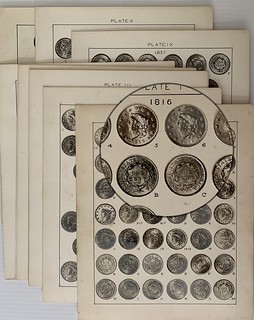
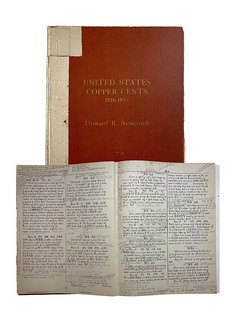
Lots 89 and 90
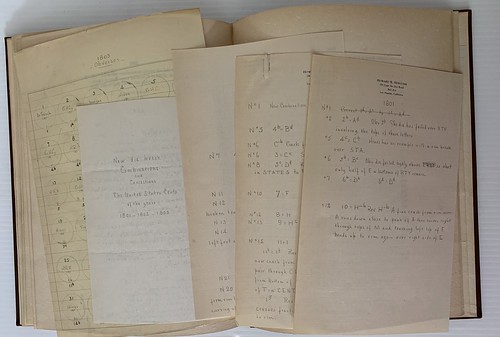
Lot 71
To read the earlier E-Sylum article, see:
CHARLES DAVIS LITERATURE SALES ANNOUNCED
(https://www.coinbooks.org/v23/esylum_v23n41a02.html)
REINER SEUPEL ISLAMIC NUMISMATIC LITERATURE SALE
Dr. Florian Haymann of Antike Numismatik in Frankfurt am Main, Germany submitted this note about literature on Islamic Numismatics in their upcoming sale of the collection of Reiner Seupel. Thank you. -Editor
Last year, Reiner Seupel, an enthusiastic collector of Islamic coins passed away in Frankfurt, Germany. He had been well known in the Oriental Numismatic Society. His coin collection will be sold in our upcoming auctions, starting with auction 427, on November 4.
What is even more worth mentioning is that his collection of rare books will also be offered in our auction. It starts with lot no. 832 (the very rare Novas observationes in quosdam numos Abbasidarum by G. A. Arri) and consists of some 100 books, some of which being extremely rare such as the sought after Fraehn volumes (nos. 853-855) and Krehl's De numis Muhammadanis in Numophylacio Regio Dresdensi (no. 873).
Here's a link to our auction:
https://peus-muenzen.auex.de/Auktion/Onlinekatalog?intAuktionsId=949
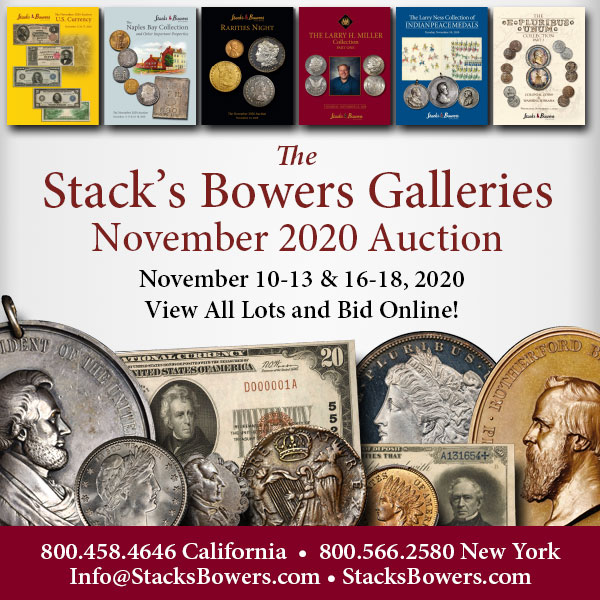
NEW BOOK: SOUTH CAROLINA MERCHANT TRADE TOKENS
"I have just published my second book on South Carolina tokens. Titled Numismatics of South Carolina, Volume I – Merchant Trade Tokens, the book is hardback with sewn-in binding in 8x11 format. It contains 777 pages and catalogs 3200 tokens, with 3500 full-color photographs and extensive histories on every token issuer. $85 postpaid. Available from me (chibbaro@mindspring.com) or on eBay."
Congratulations on the new book. Here's the eBay information and link. -Editor
Brand new token book now available for shipping. Numismatics of South Carolina, Volume I, Merchant Trade Tokens. Book contains all presently-known trade tokens issued and utilized in South Carolina from 1830 to 1960.
This book is the first volume in a series on numismatic items of South Carolina. (Volume II is presently in preparation and will be on National Bank Notes of South Carolina.)
- Hardback
- 8 1/2 x 11 inches
- 777 pages
- 3200 trade tokens listed, each one with a rarity rating and an estimated value
- 3500 full-color photographs
- 30 years worth of research
- full of historical information on token issuers
- part token catalog, part history book, part encyclopedia
- $85.00 postpaid to US addresses
For more information, or to order, see:
NEW TOKEN BOOK - MERCHANT TRADE TOKENS OF SOUTH CAROLINA by Tony Chibbaro
(https://www.ebay.com/itm/NEW-TOKEN-BOOK-MERCHANT-TRADE-TOKENS-OF-SOUTH-CAROLINA-by-Tony-Chibbaro/372981806240)
Tony adds:
"My book on national banknotes of South Carolina is projected to be around 350 pages, same format – hardback, 8x11 size, full color, complete histories on each bank. It will be Volume II in the Numismatics of South Carolina series."
We'll look forward to it! -Editor
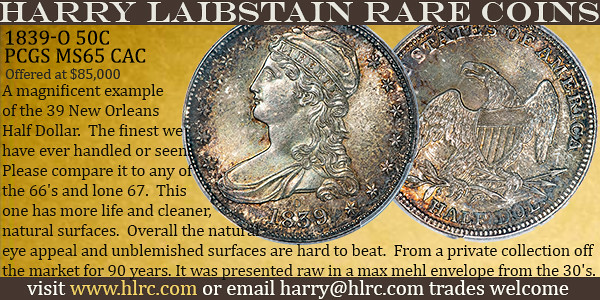
REVIEW: ANCIENT COINS IN EARLY AMERICAN AUCTIONS
Christopher McDowell submitted this review of David Fanning's new book on ancient coins in early American auctions. Thanks! -Editor
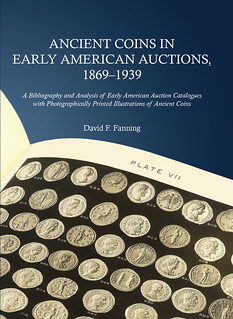 Review of David F. Fanning's new book Ancient Coins in Early American Auctions, 1869-1939.
Review of David F. Fanning's new book Ancient Coins in Early American Auctions, 1869-1939.
By Christopher R. McDowell
A few weeks ago, I saw an advertisement to pre-order David Fanning's new book. I initially hesitated to do so because I have almost no interest in ancient coins. Still, my curiosity got the better of me, and I placed an order. I am delighted with my impulse decision. At the outset, I must say that one does not have to be a collector of ancient coins to enjoy David's book; however, I presume that if your collecting interest leans in that direction, the book will bring you even more enjoyment.
Readers should not skip the book's introduction. The information contained there transcends the topic of ancient coin auctions; it presents a concise history of coin collecting and auction catalogs outside the scope specified in the book's title (the 1869 date in the title refers to the first illustrated ancient coin catalog to appear in America). David surveys the eighteenth-century American collecting scene and describes the history of coin auctions in America from the early 1820s to World War II. Much of the information presented in the introduction was new to me.
In addition to an overview of the subject matter, David provides a detailed history of the changing technology for the production of numismatic auction catalog illustrations. While this may sound a dry topic, it is not. The information I learned in this section rises above ancient coins—it applies to every image of coins and medals that appeared during the period under consideration. At the risk of sounding ignorant, I was blissfully unaware that in 1897 the federal government determined that photography of U.S. coins ran afoul of anti-counterfeiting laws and that this prohibition remained in effect until 1904 when the Chapman Brothers successfully challenged it. As a result, there is a seven-year gap in the photographic record of American coin sales. There are many other such nuggets of knowledge contained in the introduction. Quite honestly, after reading just the introduction, I felt I had received my money's worth.
After the introductory section, David looks at every significant cataloger in alphabetical order. He examines all the catalogs they produced containing illustrations of ancient coins. Plates from these catalogs containing ancient coins are beautifully reproduced, along with short biographical sketches of over a dozen catalogers. While the focus is on those auction catalogs in which ancient coins appeared, the biographies are comprehensive of all the major and some minor catalogers' lives. The information is presented in a well-written and thought-provoking fashion that effortlessly holds the reader's interest; which one would expect from an author with a Ph.D. in English. I admit that I started off intending to skip through the material but ended up reading every entry, even finding myself marveling at the plates of ancient coins.
At the conclusion of the book is a compendium of statistical information and analysis of the auction material presented along with a listing of the author's opinion as to the top early American auction catalogs for ancient coins. Perusing this material made me long for a similar book comprising American Colonial coins. Hopefully, we will one day see additional numismatic series covered to the same thorough extent. I highly recommend David Fanning's new book to anyone interested in numismatics.
I've also had a chance to see David's book, and I heartily second Chris McDowell's observations. It's a substantial work of 279 numbered pages, nicely hardbound in blue cloth with a glossy dust jacket. The color photos are of high quality.
As Chris noted, the book's Introduction is a short but substantive overview of not only the importance of auction catalogs in determining provenance, but also of the history of coin collecting in America - two core topics that should be mastered by all serious collectors. The capsule biographies of major U.S. coin dealers are just as important - every serious American numismatist should acquaint themselves with these historical figures of the old school.
The book includes some interesting but appropriate diversions from the main topic, such as Thomas Elder's c1909-1910 photos of his own collection of silver coins of Alexander the Great (p84-85).
I agree there would certainly be a good market for books providing a similar roadmap to American Colonial coins as well as other popular topics in auction catalogs (such as medals and tokens). Many of the better auction catalogs in my own library came via my purchase of Donald Miller's library. He shared my interest in tokens, and this is reflected on the shelf to my right which includes a plated Bushnell sale and interleaved and plated copies of the 1865 and 1884 Levick sales.
Congratulations to David Fanning for an important contribution to multiple fields: ancient coinage, American numismatic history, and the literature of numismatic literature itself. -Editor
To read earlier E-Sylum articles, see:
ANCIENT COINS IN EARLY AMERICAN AUCTIONS
(https://www.coinbooks.org/v23/esylum_v23n34a19.html)
NEW BOOK: ANCIENT COINS IN EARLY AMERICAN AUCTIONS
(https://www.coinbooks.org/v23/esylum_v23n38a02.html)

WHITMAN ENCYCLOPEDIA OF COLONIAL COINS
This overview of the Whitman Encyclopedia of Colonial and Early American Coins by Ken Bressett comes from the new edition's Foreword. Submitted by Dennis Tucker of Whitman Publishing. Thanks! -Editor
“Hardship, Heartbreak, and Opportunity”—The Fascinating Tales Told by Colonial and Early American Money
by Kenneth E. Bressett
The second edition of the Whitman Encyclopedia of Colonial and Early American Coins debuted in September 2020. This essay is condensed from the book's foreword, by Kenneth Bressett.
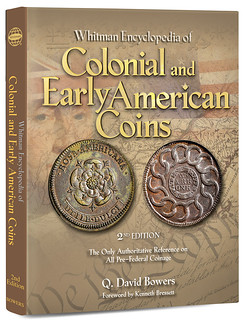 The story of money, its everyday use in commerce, and how it is created for payment of taxes and use in trade, presents a chronicle of the people, the tribulations, and the progress of every nation. Knowledge of the various kinds of coins and other money used during the formation of the United States is essential to understanding the character of its early settlers, the problems they faced, and steps that were taken to overcome the many hardships associated with achieving some degree of economic freedom and stability.
The story of money, its everyday use in commerce, and how it is created for payment of taxes and use in trade, presents a chronicle of the people, the tribulations, and the progress of every nation. Knowledge of the various kinds of coins and other money used during the formation of the United States is essential to understanding the character of its early settlers, the problems they faced, and steps that were taken to overcome the many hardships associated with achieving some degree of economic freedom and stability.
Money that was used in early America was nothing at all like the coins, paper bills, and credit cards used today. It would have been as difficult for the original settlers to envision electronic transfers as it is for us to think about having to do without a standard monetary system, or the checks, coins, and currency we use to facilitate trade. For colonizers of a new land it was far more essential to journey with the essentials of life that must have included clothing, household goods, farm equipment, tools, and barter items. With no place to spend money, the early settlers in America were not overly concerned about bringing cash with them to their new home.
Most of the early American settlers were farmers or small merchants looking for a better life. They had heard stories about rivers teeming with gold and precious gems, and while both they and the English government longed for immediate riches, their goal was mainly to ensure economic growth. The men hunted, built homes, and farmed, while the women cooked, made preserves, spun, and made clothing. Theirs was a self-sufficient society that relied on barter and needed little outside assistance or money. But that was not what the king of England hoped to achieve in the plantations that were intended more as a source of exports to the mother country.
Early commerce in New England consisted of exchanging goods with the natives, by which valuable furs were obtained for export. In England they were used to acquire needed supplies and items that could not be produced locally. Beaver skins, wampum, imported trinkets, grain–and, in Virginia, tobacco–soon became the commonly accepted media of exchange for all other available commodities. The settlers had little use for coined money at first, but when traders came from foreign lands, coins were usually demanded in payment for goods. Coins that did occasionally come from England were immediately returned in payment for essential items from the homeland.
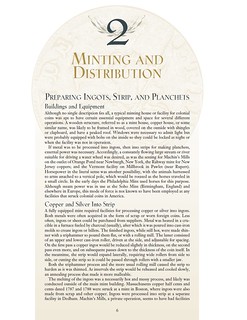
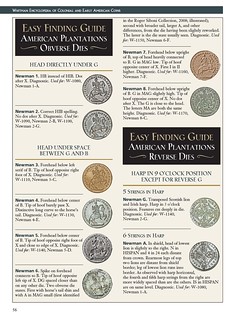
Gold and silver coins of all nations were accepted in normal dealings by the colonists who in turn used them to purchase imported goods. English copper and silver coins were familiar and desirable, but of equal value were the German thalers, Dutch silver lyon (lion) dollars and gold ducats, French louis, and, of course, the ever-present gold doubloons and silver pieces-of-eight and their fractions from Spain as well as mints from Mexico to South America. English copper coins served the need for small change, but even these were scarce and rarely adequate for commercial needs.
In time, barter out of necessity became the prime medium of exchange within the colonies. Europeans were anxious to purchase fish and pelts from America, and the colonists were eager to accommodate them by bartering for those items with the Indians. Beads, knives, hatchets, and blankets were the favorite items. Trade with Europe was necessary and brought in powder, shot, guns, nails, and other provisions, thus adding to the shortage of coined money in the colonies. By and large, the colonization of British North America began and grew under the principles of mercantilism, a system whereby the colonies were expected to buy English finished goods and pay for them by sending locally abundant raw materials to England to supply her factories and stores. Colonial trade policy and England's mercantile system in general were governed by the English Board of Trade, which regulated commerce, raw materials, manufacturing, and shipping. Trade with any other country was discouraged in an effort to keep the colonies dependent on England.
The British mercantile system required gold and silver to be used in England, and largely prevented the colonies from using anything but barter. As inhibiting as this was, the barter system at least served communities well for domestic needs, and the Americans even continued to exchange goods, services, and products well beyond the period of British control.
From 1637 to 1661, Indian wampum became a standard medium of exchange for trade with the Native Americans. Wampum, basically strings of colored shell beads, was highly coveted and could be exchanged for furs. Six white beads or three blue beads equaled one English penny. All financial records were kept in the traditional English pounds, shillings, and pence, but debts and taxes were often paid in corn, beaver, or whatever foreign coins were available. The terms “country pay” and “corn” referred to a number of different kinds of grain or even peas, and all were accepted by some colonial treasuries for payment of taxes.
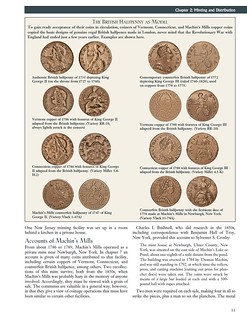
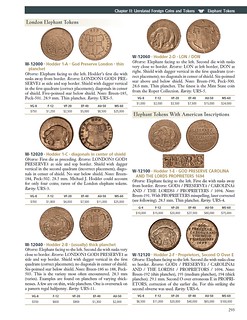
To a great extent, the saga of the American colonization effort is a story of the settlers' struggle to achieve a degree of economic sufficiency in defiance of unsympathetic British policies. Self-sufficiency, which could be better called “liberty,” meant the opportunity to market surplus produce at reasonable prices, and to use the income for necessities, or even an occasional luxury. This, however, was not the royal intent, and every possible obstacle was used to force a kind of restricted trade with England that would favor the Crown and leave the colonists with only the barest of necessities—and a continuing need to trade with the homeland.
Coining money was considered a royal prerogative and was forbidden to the colonists. Some trade did go on with other foreign merchants, and small quantities of Spanish-American coins did circulate here, as well as other gold and silver pieces, but most local transactions had to rely on barter or trade without the use of coins. In time, just about anything that even looked like a coin was considered spendable. It was not until 1652, during the reign of Oliver Cromwell, three years after King Charles was removed from the throne, that coinage became an issue, and the Massachusetts Bay Colony faced the issue squarely. A mint was established in Boston to provide a coinage that could be used to satisfy local needs and to counteract debased Spanish-American silver coins. The coins made at that historic facility were produced over the next 30 years in defiance of British law. The date 1652 was continued in use on them by convention, representing the date of authorization by the colony. It is a matter of debate as to whether the maintaining of this date was intended to hide from British authorities the fact that the coins were made far beyond Cromwell's time.
Mark Newby, a Quaker merchant, came to New Jersey in 1681 with a group of immigrants and a quantity of Irish coins known as St. Patrick's halfpence. The legislature of the colony made them legal tender for that amount. In 1688, Richard Holt, a British entrepreneur, arranged for a quantity of tin tokens to be made for the American plantations, but these never crossed the Atlantic.
Over the years British financial policies created many hardships and ill feelings towards the Crown. They prompted acts of defiance such as the Massachusetts coinage that was seen by some as the “first Declaration of Independence.” Later there were other revolts against taxation and fiscal controls that seemed to be against the best interest of the colonists. The Stamp Act of 1765 was particularly offensive because it was seen as taxation without representation and a restriction on the freedom of the press. In Boston, reaction to the British tax on tea was swift and harsh.
Some relief from the always-prevalent coin shortage in America was promised to the colonies in 1722 when William Wood, an English businessman, obtained a patent from King George I to make tokens for Ireland and America. These were to be lightweight brass pieces that would facilitate trade in the colonies, and not likely to be returned to England because they were not made to the same standards as regal coins. Some were sent to America along with the “Rosa Americana” pieces that had been made expressly for the colonies. Both circulated for a short time, but despite the desperate need for small change, these coins were widely rejected because of their weight, and the experiment died the following year.
Among the many kinds of coins and tokens used to facilitate trade in the early colonies were those from France that were made either for homeland or colonial use, English merchants' coins and tokens, and nearly anything imported from Europe that could be called a “coin.”
When the British government agreed to make an issue of copper coins exclusively for Virginia in 1773, they again were lightweight and included an image of King George III, who by then was not very popular with Americans on the verge of revolution. The coins were considered too little and too late to help with the economic future of a new country; it was time to begin thinking about becoming self-sufficient in every way. In 1776 the Continental Congress proposed an issue of coins with a design inspired by Benjamin Franklin. For some reason, that coinage never progressed far beyond a limited distribution of pewter pieces. Specimens today are considered to be rare and valuable collector items. New Hampshire proposed a coinage in 1776, but the idea did not progress past the pattern stage. Another early attempt to provide the states with a uniform coinage was tried when copper coins dated 1783 with the legend NOVA CONSTELLATIO were made under contract with a private mint in Birmingham, England, and imported for use in America.
Various other patterns and state-authorized coinages were proposed and started in the period from 1785 through 1788. Each is a chapter in the history of early America and tells of the measures taken by Vermont, Connecticut, New Jersey, New York, and Massachusetts to provide coinage for the beginning nation. Mixed with these states' efforts were a number of tokens and coins sent here in commerce, while others were imported by merchants from overseas for local use.
The extensive assortment of coins and tokens pressed into use prior to the establishment of the American monetary system is formidable. Detailed accounts of various segments of these have been published in many forms; today they are presented in one convenient source—the Whitman Encyclopedia of Colonial and Early American Coins. Author Q. David Bowers has spent a lifetime researching this absorbing topic. He has carefully documented each coin type, along with all of the notable variations that hold such high interest for collectors.
The story of money in early America reflects the hardships, heartbreaks, opportunities, conquests, and political horse-trading that went into winning financial freedom for the emerging nation. It is a story reflected and amplified in each of the coins described in the Whitman Encyclopedia of Colonial and Early American Coins.
To read the earlier E-Sylum article, see:
NEW BOOK: WHITMAN ENCYCLOPEDIA OF COLONIAL COINS, 2ND ED.
(https://www.coinbooks.org/v23/esylum_v23n35a04.html)

AUSTIN M. SHEHEEN, JR. (1934-2020)
David Gladfelter passed along word of the passing of paper money dealer Austin Sheheen at the end of August. Austin formerly owned Bank Note Reporter, received a Numismatic Ambassador award from Krause Publications in 1988, was a past president of the Society of Paper Money Collectors and is in its Hall of Fame. -Editor
"He was a CPA and was well known and well liked by paper money collectors. He wrote at least one book, South Carolina Obsolete Notes and Scrip, published in 2003 and printed for him by Midlands Printing, Inc., in Camden, S.C. where he lived. It was one of the first books on paper money to be illustrated full size in color.
Here are a couple great photos of Austin from his daughter Amanda's website, followed by some remembrances republished with permission from the October 10 and October 17, 2020 issues of the MPC Gram. Thanks. -Editor
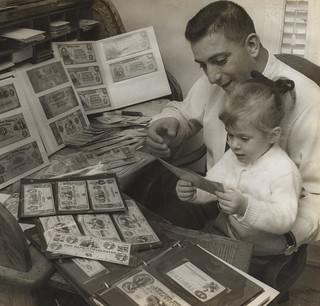
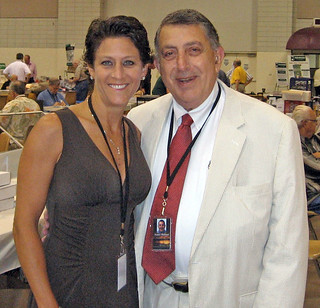
Austin Sheheen with daughter Amanda in 1969 and again at a Memphis Paper Money show
Fred Schwan writes:
"Austin Moses Sheheen, Jr, a fixture and leader among paper money collecting and publishing died Saturday, August 29. 2020. Austin was a collector of paper money for more than seventy years. His greatest collecting passion was the paper money of South Carolina, but he collected Military Payment Certificates and other areas as well.
"He wrote a catalog of South Carolina paper money, owned and published the backbone of our hobby--the Bank Note Reporter. His tenure at the helm of the BNR came at a critical time in the history of the publication. He bought the paper from Grover C. Criswell and sold it to Chester Krause. He served as president of the Society of Paper Money Collectors and treasurer of the American Numismatic Association.
"Austin was a successful business man and devoted family man. He is survived by his wife, Joan, of many decades, seven daughters twenty five grandchildren and thirty-three great-grandchildren."
Joe Boling writes:
"Another loss to the community. Austin was a South Carolina specialist; he published South Carolina Obsolete Notes and Scrip in 2003. I got on his good side early when I found a previously-unknown note from SC in a Portland, Oregon junk box and sold it to him at the next Memphis. I had no idea how good it was when I bought it; I just thought he might have a home for it.
"I don't remember when I first met Austin, but since the third ANA I attended was in Atlanta ('77) and the next one in Houston, it was probably at one of those shows. Not long after, Grover Criswell was ready to sell the Bank Note Reporter, and Austin bought it. Someplace in there Fred and Austin created the BNRPress to compliment the paper. Fred was the publisher. Of course, Krause Publications ended up with BNR, but Fred retained the book publishing side of the firm (KP did not need another imprint), so BNR Press moved to Port Clinton.
"The last time I recall seeing Austin was at FUN 2018, where I bought a copy of the book mentioned above. Despite being 14 years old, it was new to me. He was no doubt at the ANA shows between then and now, but I am so busy at ANA conventions that I am not able to walk the floor and visit with folks. Soft-spoken, plain-spoken, and a pleasure to talk to—that's how I remember AUSTIN M. SHEHEEN, JR."
Here are some additional notes from E-Sylum readers. -Editor
Tony Chibbaro writes:
"I first met Austin in 1985 at a coin show being held in Columbia, SC at the old Holiday Inn Hotel across from the Carolina Coliseum. I had just become interested in collecting trade tokens and had developed a plan to write my first book on the subject. I was 28 years old, still wet behind the ears as a numismatist, but had a certain degree of enthusiasm that Austin must have picked up on. I had learned from another source that Austin had just purchased a collection of tokens from Randy Chambers, a pioneering collector of South Carolina tokens who had amassed the largest group around. Anyway, after explaining my plans to write a book on the subject, Austin proceeded to give me unfettered access to his holdings, and soon allowed me to take the entire collection home with me to catalog and photograph at my leisure! This is the kind of person Austin was - kind, generous, and always eager to share his time and expertise with anyone who asked."
Steve Hayden writes:
"I was very sad to hear the news even though I didn't know him well, just scattered meetings at coin shows and some dealings with South Carolina tokens I was collecting at the time. He was an upbeat, positive person and fun to be around. Well liked and respected by all who knew him."
Thanks, everyone! -Editor
To visit Amanda Sheheen's A&O currency website, see:
http://www.aocurrency.com/
To read Sheheen's online obituaries, see:
Austin Moses Sheheen, Jr.
(https://www.kornegayfuneral.com/obituary/austin-moses-sheheen-jr)
Austin Sheheen
(https://www.legacy.com/obituaries/thestate/obituary.aspx?n=austin-sheheen&pid=196720097&fhid=8963)
Austin Sheheen
(https://www.legacy.com/obituaries/name/austin-sheheen-obituary?pid=196720097&page=2)
JOEL R. ANDERSON (1944-2020)
Dennis Tucker of Whitman Publishing submitted this note on the passing of Joel R. Anderson. Thank you. Sorry to hear the news! -Editor
Hobby Community Mourns the Loss of Businessman and Philanthropist Joel R. Anderson
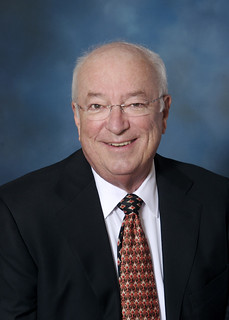 Joel R. Anderson, of Florence, Alabama, died peacefully at home on Monday evening, October 12, 2020, from natural causes at the age of 76. He was well known in the numismatic world as a businessman and generous supporter of many hobby causes.
Joel R. Anderson, of Florence, Alabama, died peacefully at home on Monday evening, October 12, 2020, from natural causes at the age of 76. He was well known in the numismatic world as a businessman and generous supporter of many hobby causes.
The Anderson family has been active for decades in numismatics, publishing, and media distribution, among other industries. This started in 1917 with a street-corner newsstand built in downtown Florence by his late father, Clyde W. Anderson. The Anderson Companies grew into a business that today includes Anderson Media Corporation; TNT Fireworks (the largest importer and distributor of consumer fireworks in the United States); specialty publisher Anderson Press; and Books-A-Million (the nation's second-largest book retailer).
Joel Anderson attended the University of North Alabama and then worked in his family businesses. He served as a director of many affiliated firms and chairman of the Anderson Companies, which today employ more than 11,000 associates in the United States, the United Kingdom, Hong Kong, and China.
A Longtime Hobby Supporter and Enthusiastic Collector
Among hobbyists and collectors, the best-known Anderson brands are ANCO (manufacturer of coin tubes and other supplies); Cowens (cardboard coin holders); H.E. Harris & Co. (stamp dealer, publisher, and philatelic supplier); and Whitman Publishing, the largest publisher of numismatic books and supplies, and creator of the annual Guide Book of United States Coins (the “Red Book”).
Joel Anderson was an active supporter of the American Numismatic Association, the American Numismatic Society, and other hobby organizations. “Mr. Anderson believed in the power of literacy, research, and education,” said Whitman president Mary Burleson. “He gave generously of his time, business expertise, and financial resources to strengthen every aspect of the hobby. He did this quietly, without fanfare, never seeking praise or publicity for himself.”
Anderson was a serious collector of rare United States paper money. In 2018 and 2019 his collection was sold by Stack's Bowers Galleries for more than $34 million. It was the most valuable cabinet of U.S. paper currency ever dispersed at public auction.
A Positive Influence in Many Worlds
Friends from across the wide spectrum of the Anderson family's business and civic activities are mourning the loss of Joel Anderson. In the world of pyrotechnics, he is remembered as the founder, chairman, and director of the American Fireworks Standards Laboratory. (Dr. John A. Conkling, in Boom: America's Ever-Evolving Fireworks Industry, wrote of Anderson's “strong and capable leadership” of the safety and testing organization, which is credited with reducing the number of fireworks injuries and fatalities.) Medical organizations such as the Cardiovascular Institute of Philadelphia and the American Heart Association celebrate him as a trustee and supporter. His philanthropic, civic, and humanitarian endeavors have earned him the respect and admiration of the Salvation Army, the United Way, and the many schools, libraries, and museums that he championed and served.
The Anderson family shared some words of wisdom Joel Anderson gave in a letter to his grandchildren, exemplifying his life philosophy: “Always smile and feel happiness and it will become a part of you. Always be positive and if you are sometimes defeated in something, don't pout, don't complain, just turn around and take another path to winning. Always respect others, always be honest with others and, very importantly, yourself. Always go out of your way to do the right thing in any situation and always remember to be nice and share with others, especially persons who need a helping hand.”
Anderson is survived by his wife, Carmen Hemmer Anderson; daughters, Ashley Ruth Anderson and Kristen Lore Anderson; son, Joel Ray Anderson II (Sophie); brother, Charles Caine Anderson; sister, Jan Anderson Wiggins (Bob); grandchildren, Kate Brooklyn Billingsley, Grant Ray Billingsley, and Stella Ruth Chanin; niece, Catherine Foss Wingfield; nephews, Anderson Malone Wingfield, Charles Caine Anderson Jr. (Moll), Terrence Carroll Anderson (Susan), Clyde Barbour Anderson (Summer), and Harold Myron Anderson (Amber). He was preceded in death by his father, Clyde W. Anderson; mother, Ruth Keenum Anderson; and sister-in-law, Hilda Barbour Anderson.
There will be a drive-by visitation at 1:00 p.m. on Friday, October 16, followed by a private graveside service for family at 3:00 p.m. at Greenview Memorial in Anderson's hometown of Florence, Alabama.
The family welcomes donations, as an expression of sympathy in lieu of flowers, to the American Heart Association, the University of North Alabama, or United Way of Northwest Alabama.
John Feigenbaum of the Coin Dealer Newsletter published a remembrance on October 15, 2920. See the complete article online for a full biography of Mr. Anderson. The image is of Joel Anderson (left) with John Feigenbaum at Mr. Anderson's annual holiday party in New York City (December 2007). -Editor
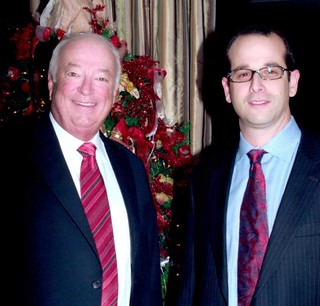 It is with a truly heavy heart that I learned the news of the passing of a friend and numismatic colleague, Joel Anderson. Joel was not seen often on the bourse floor at shows, but he was a huge presence in our industry and was beloved by all of us that had the opportunity to get to know him. The smile in the picture here perfectly matches his personality in real life. I personally had the opportunity to do business with Joel -- buying and selling -- in the early 2000s. He was always friendly and humble and a pleasure to do business with.
It is with a truly heavy heart that I learned the news of the passing of a friend and numismatic colleague, Joel Anderson. Joel was not seen often on the bourse floor at shows, but he was a huge presence in our industry and was beloved by all of us that had the opportunity to get to know him. The smile in the picture here perfectly matches his personality in real life. I personally had the opportunity to do business with Joel -- buying and selling -- in the early 2000s. He was always friendly and humble and a pleasure to do business with.
To read the complete article, see:
Joel Anderson: a Quiet but Huge Force in Numismatics, Has Passed Away at the Age of 76
(https://www.greysheet.com/news/story/joel-anderson-a-quiet-but-huge-force-in-numismatics-has-passed-away-at-the-age-of-76)
For more information, see:
Joel Anderson
(https://www.timesdaily.com/obituaries/joel-anderson/article_b8ac493a-ea6f-5e17-8eaf-3e4ea7e005c2.html)

NEWMAN PORTAL: FIRST HALF EAGLE STRUCK IN 1795
Newman Numismatic Portal Project Coordinator Len Augsburger provided the following report. Thanks. -Editor
The First Half Eagle Struck in 1795
A research query forwarded by Q. David Bowers pointed us toward the biography of Henry William de Saussure, the second director of the U.S. Mint, who had a short tenure in that position, July -October 1795. Written in 1841, the biography lends a charming anecdote regarding the Mint under de Saussure:
“General Washington, whose habit was to see the heads of departments every week at his table, upon one of these occasions, expressed to the director of the mint his satisfaction at the activity which had been introduced into the silver coinage, and added, ‘I have long desired to see gold coined at the mint but your predecessor found insuperable difficulties. I should be much gratified if it could be accomplished before I leave office.' ‘I will try,' was the reply ; and the director went to the mint, summoned the officers, ascertained the wants and difficulties of each department, and by great diligence, speedily removed all obstacles. In six weeks he carried to the President a handful of gold eagles, and received his thanks and approbation.”
Breen's Encyclopedia gives a coining period of July 31 to September 16, 1795, for the first half eagles and further states that the half eagle dies were in production while David Rittenhouse was still Mint Director. A $5 gold piece from the Yale University collection, said to have been the first struck and reputedly owned by Martha Washington, was stolen in the 1960s, along with a Brasher doubloon and other pieces, and never recovered.

The piece is alluded to in correspondence from Dick Picker to Eric Newman, May 1, 1962, after Yale curator Ted Buttrey exhibited the piece at the New York Numismatic Club. Buttrey commented to Len Augsburger via email on June 17, 2017,
“The $5 gold, like the Brasher, was part of the Yale collection which I curated. The collection was stolen after I left Yale in 1964. The Brasher showed up later, but there is no way to trace the $5.”
Link to Memoir of the life, character, and public services, of the late Hon. Henry Wm. De Saussure on Newman Portal:
https://nnp.wustl.edu/library/book/589594
Link to Richard Picker correspondence on Newman Portal:
https://nnp.wustl.edu/library/archivedetail/520539
VIDEO: DENVER COIN EXPO DURING COVID VIRUS
These are selections from the David Lisot Video Library that feature news and personalities from the world of coin collecting. David has been attending coin conventions since 1972 and began videotaping in 1985. The Newman Numismatic Portal now lists all David's videos on their website at:
https://nnp.wustl.edu/library/multimediadetail/522852
Here's one on the October 2020 Denver Coin Expo. -Editor
Walkabout with David Lisot at Denver Coin Expo During COVID Virus October 3-5, 2020.
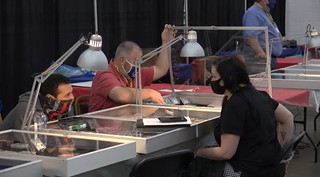 David Lisot, Host, CoinTelevision.com, with Cayden & Scott Allen, Glenna Brewer, Buck Burgess, Neal Hatgi, Denver Coin Expo, Don Kagin, Kagin's Auctions, Chad Morgan, Diana & Jeff Wuller, Jaye Watermann, and lots of coins!
David Lisot, Host, CoinTelevision.com, with Cayden & Scott Allen, Glenna Brewer, Buck Burgess, Neal Hatgi, Denver Coin Expo, Don Kagin, Kagin's Auctions, Chad Morgan, Diana & Jeff Wuller, Jaye Watermann, and lots of coins!
David Lisot braves the Corona Virus at the Denver Coin Expo to bring you news about one of the first major regional coin conventions. David talks to Neal Hatgi, promoter of the show to find out all the precautions taken to ensure a safe coin collecting experience. He talks to dealers and collectors including Don Kagin and Jeff Wuller. He shares with Glenna Brewer about the passing of her youngest son, Adam Brewer, and his life of collecting. Plus he shows you lots of coins and tips how to have a successful convention. DCE20-001
An excerpt of the video is available for viewing on the Coin Television YouTube Channel at:
https://youtu.be/FispYE25QO0

P.O. TREMBLAY CORRESPONDENCE DIGITIZED
Canadian Coin News published an article about the Newman Numismatic Portal's digitization of correspondence of Quebec numismatist P.O. Tremblay. Here's an excerpt - see the complete article online. -Editor
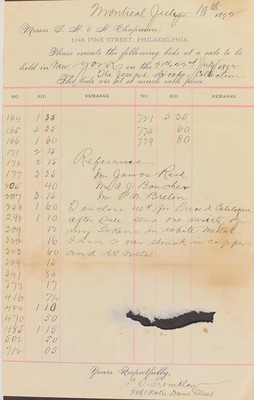 Correspondence between a pair of Philadelphia dealers and historic Québec numismatist P.O. Tremblay, once the curator of the Antiquarian and Numismatic Society of Montréal, has been digitized and offered online for free.
Correspondence between a pair of Philadelphia dealers and historic Québec numismatist P.O. Tremblay, once the curator of the Antiquarian and Numismatic Society of Montréal, has been digitized and offered online for free.
From the American Numismatic Society archives, the digitized correspondence includes business discussions, auction catalogues and other material sent between 1869 and 1949.
Born in 1864, Tremblay began collecting coins at age 15. Seven years later, in 1886, he started working as an ironmonger on Notre-Dame Street in Montréal.
Tremblay's correspondence with the Philadelphia dealers – brothers Henry and Samuel Hudson Chapman, who worked between 1880 and 1935 – primarily focuses on the latter's bidding in the Chapmans' sales.
To read the complete article, see:
Montréal numismatist's correspondence with U.S. dealers digitized
(https://canadiancoinnews.com/montreal-numismatists-correspondence-with-u-s-dealers-digitized/)
COLONIAL COIN COLLECTORS 2020 VIRTUAL CONVENTION
The Colonial Coin Collectors Club (C4) will be holding their 2020 convention online, and everyone is welcome to attend. Here's the announcement. -Editor
Educational Programs For Its 2020 C4 Virtual Convention
The Colonial Coin Collecting Club (C4) has released the schedule of online education programs as part of its virtual 2020 Convention, to take place November 12 – 14, 2020. These programs will be fully accessible on Zoom. The programs will appeal to collectors of every level of experience with colonial coins and currency, from the curious beginner to those with colonial expertise. You do not need to be a member of C4 to participate. A lineup of luminaries in the hobby has been assembled to deliver a varied and fascinating educational experience.
All programs will be available on Zoom, and will be one hour in length. A tutorial on how to use Zoom and more detailed information on how to join lectures will be posted on the C4 website in the “Convention” section: https://colonialcoins.org/conventions/
Three of the programs have been designated Newman Lectures, named for famed numismatist and author Eric P. Newman. The schedule of programs is as follows:
Thursday evening, November 12, 2020: (Newman Lectures):
7:30 p.m. - Dr. Roger Moore: “The Long and Twisted Road to Virginia
Halfpence.”
8:45 p.m. - Dr. David Menchell: “Betts and Other Medals That
Demonstrate the Early Fight for Dominance in the Caribbean.”
Friday evening, November 13, 2020:
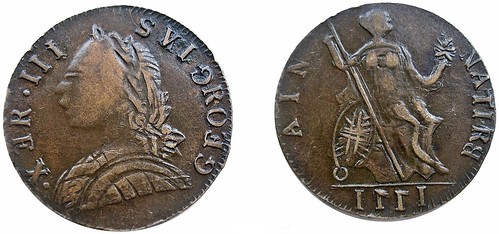
7:30 p.m. - Jeff Rock: “Make It and Fake It: An Introduction to British
and Irish Coppers Used in Colonial North America.”
8:45 p.m. - John Kraljevich: “The Immigrants: Sources and Methods"
(Newman Lecture)
Saturday afternoon, November 14, 2020:
2 p.m. - Jim Glickman: “Colonial 101”
3:30 p.m. - Leo Shane: “Colonial Currency - Patriotism in Print”
(Note: All times Eastern Standard Time.)
Jack Howes, President of C4, said “with COVID-19, we cannot assemble
as usual at the Baltimore Whitman Show. Instead, C4 is offering a
wonderful set of online programs with an impressive group of
presenters.” Jim Glickman, C4 Educational Co-Chair, said “With these
programs, we are seeking to offer as much of the C4 convention
experience as possible, while being able to offer programs to a wider
audience.”
To access the programs, which are free, please go to the C4 website:
https://colonialcoins.org/conventions/

DASSIER'S KINGS AND QUEENS OF ENGLAND MEDALS
Regarding the framed plaster medallions reader Whitney Allen asked about, Pete Smith writes:
"These are medals of the kings of England including Charles I, George I and William I.
"The dies were originally executed by Jean Dassier for a series of 33 medals issued in 1731. Caroline was soon added to the 1731 set to make 34. In 1830 the set was re-issued with George III and George IV added to make 36 in the set."
"It is difficult to identify medals when only one side is shown. I do not have any information about a series of such medals being issued in plaster."
Here's some more information from the website of Hedley Betts. -Editor
Dassier's Kings & Queens
Jean Dassier of Geneva published a series of 34 medals of the Kings and Queens of England in 1731. They were offered for sale in England at 6 guineas in bronze and 15 guineas in silver. They were also available in damascened bronze with the fields of the medals bronzed and the relief gilded. The dies for the series came into the possession of Sir Edward Thomason, who reissued the medals around 1820.
The earlier medals were struck on slightly thinner flans with slightly beveled edges. They have a finish that is a little duller. The later issues have slightly more reflective surfaces and vary in the color of their patination. Some show signs of die wear and defects. Examples cast from struck medals also exist. They are slightly smaller in size and poorer in quality.
For more information, see:
Dassier's Kings & Queens
(https://www.mcssl.com/store/8596432/dassiers-king-queens)
Scott Miller writes:
"They are plaster casts of medals from the series of Kings and Queens of England by Jean Dassier. The first three are of Charles I, George I, and William the Conqueror, while the last is the reverse of a medal for Queen Caroline done at the same time."
Thanks! E-Sylum readers come through again! Scott included a link to images of the medals on Ben Weiss' website. Here's a comparison. -Editor
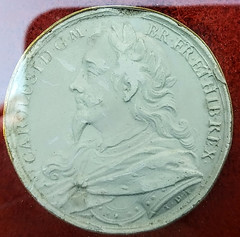
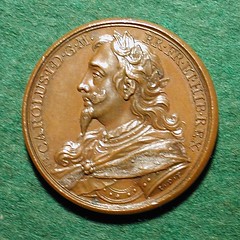
Charles I
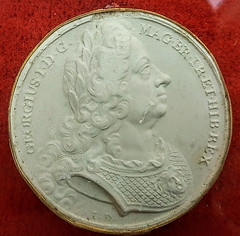
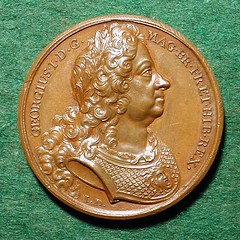
George I
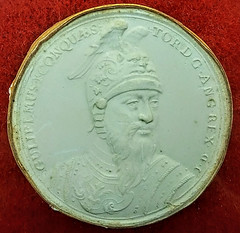
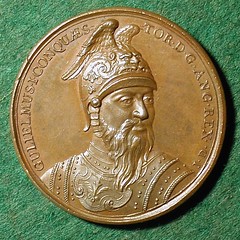
William the Conqueror
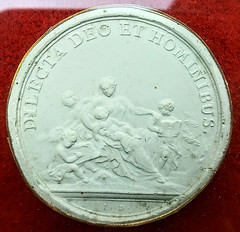
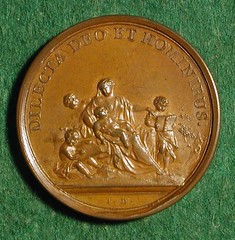
Queen Caroline reverse
For more information, see:
KINGS AND QUEENS OF ENGLAND by JEAN DASSIER
(http://www.historicalartmedals.com/MEDAL%20WEB%20ENTRIES/
THUMBNAILS/SWISS-DASSIER-KINGS%20AND%20QUEENS/brand%20new%20thumbnails.htm)
Pete adds:
"I have Eimer's book on British Commemorative Medals and their Values (1987). He does not mention plaster versions."
Internet searches for "Dassier plaster medals" lead to several references to offerings, but no information on who made these or when. I reached out to Hedley Betts and Christopher Eimer for more information. -Editor
Chris Eimer writes:
"Without examining the items in person, they would appear to date from the nineteenth century, the gilt paper surround evident on at least one of those illustrated suggesting that they were to be mounted in the form of a book."
Hedley Betts writes:
"I have seen plaster copies of Dassier's Kings and Queens. In fact over forty years ago, while I was still living in England I had a set mounted in two frames on the wall of my office. They made an attractive display and a collector from Malta was so taken with them that he eventually persuaded me to sell them. From the age of the frames, I believed them to be Victorian in origin. In fact, it seems to have been a fairly widespread practice in the nineteenth century to make copies of medals and gems and to mount them for display, since I have seen other plaster casts and electrotypes of medals and engraved gems in frames made for wall display. I have also seen them mounted in book-like display cases.
"Since they are copies, they don't have much historical or artistic significance. Their value lies more in their decorative appeal. Besides seeing plaster copies of Dassier's medals I have come across double-sided copies made of black basalts and in terra cotta with dates impressed on the reverse. These I also believe to be Victorian in origin, made from molds created from actual medals."
Edward C. Moore of Texas is the Librarian for the Conder Token Collectors Club, and he offered this overview of plaster cameos, illustrated with photos of his own collection. Thanks! -Editor
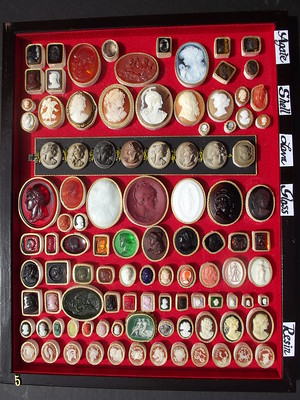
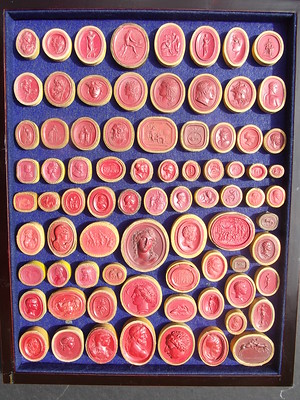
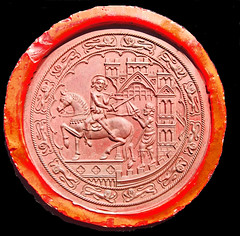 Intaglio is an Italian word, and the G is silent, so it is pronounced “INTALIO” and it means carved in. It is a depression, much like the head of a Phillips head screw. A cameo is the opposite, it is raised above the surface. Most intaglios are meant to be used to make a cameo image when pressed into clay or wax or other soft medium. Usually an intaglio is in the form of a ring or fob, a carved in family crest that can be used to make a wax or clay seal by pressing the ring into the soft clay or wax. In the Bible when the prodigal son returns, his father says to put a ring on his finger. This was no mere bobble, but a family crest ring which identifies the wearer as a member of the family.
Intaglio is an Italian word, and the G is silent, so it is pronounced “INTALIO” and it means carved in. It is a depression, much like the head of a Phillips head screw. A cameo is the opposite, it is raised above the surface. Most intaglios are meant to be used to make a cameo image when pressed into clay or wax or other soft medium. Usually an intaglio is in the form of a ring or fob, a carved in family crest that can be used to make a wax or clay seal by pressing the ring into the soft clay or wax. In the Bible when the prodigal son returns, his father says to put a ring on his finger. This was no mere bobble, but a family crest ring which identifies the wearer as a member of the family.
In Egypt, most of the people could not read or write, therefore they could not sign their name. They needed a way to sign their name so small Scarabs were carved with their name on the base carved in intaglio. These small Scarabs had a hole drilled through them and a string was put through the hole and tied around the wrist and the scarab was worn like jewelry. When the owner needed to sign his name, he could press the scarab into a soft clay tablet, and this would be his signature.
In Greece and Minoa, they took intaglio carving to the next level and carved pictures into the stone. Sometimes pictures of warriors, or the king, or lions or whatever but these intaglios took months to carve into the stone using spinning wheels and grinding powders so only royalty or very rich people could afford to own a beautifully carved intaglio.
The Etruscans copied the Egyptian Scarabs but instead of a name on the base, they carved pictures like the Greeks and Minoans. These were usually carved in carnelian agate and today, if you want to own one, prepare to spend a fortune!
When the Romans conquered the Greeks, they saw how great the Greek stone carvers were and so they used them to have their intaglios carved. The roman word for a stone carver who could carve an intaglio was “CAVITOR.”
OK, we will skip over most of the dark ages where when people found the intaglios they thought those pictures were put in the stone by God, and they carved little religious symbols into them and gave them to priests and the like.
Now we are up to about the year 1550, life has settled down and in Europe and England life is divided into rich folks and poor folks. The rich live in manor housed and the poor work the land and pay taxes to the rich. The children of the rich folks are well educated and after they graduate college, as part of their education, they are sent on what is called “The Grand Tour.” They will spend several years traveling to the great places in Europe such as Paris, Rome, Venice, and Athens. There are no museums, those have not been invented yet, so they stay with other rich folks or royalty and there they see the collections that have been gathered. They want to bring home things that they have seen in Europe! (Hold that thought.”)
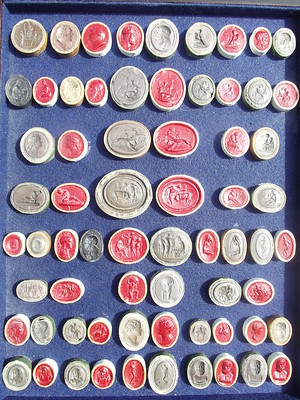
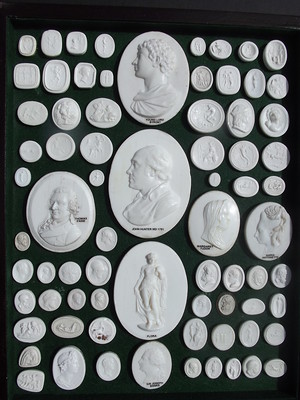
Sulphur Intaglios and Vitreous Glass Paste Cameos
You have heard the saying “Signed, Sealed, and Delivered.” This was literal, your signature on a document was not enough because someone could copy it. You had to have a Seal to accompany the signature. They would melt red wax beside your signature, and you would press your personal intaglio seal into the hot wax leaving a cameo impression of your crest or initials or whatever was carved into your seal. Rich folks had them, poor folks did not, and poor folks were jealous! By the time of the Industrial revolution in the late 1700's, every business, school, church, and gentleman had a personal seal. A man named James Tassie began collecting copies of seals. He would make impressions using melted sulfur mixed with red ochre, and his collection grew to thousands of impressions. This was a time of experimentation and he found that he could make copies of famous old seals out of glass. This was called Vitreous Glass Paste. He sells these and now everyone can own an intaglio. Josiah Wedgwood begins making black clay copies of some of them and calls them Basalt Ware. Later he will make the famous white on blue copies and call them Jasper Ware.
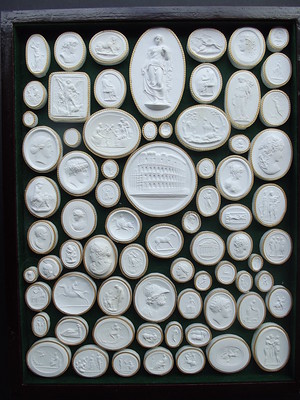
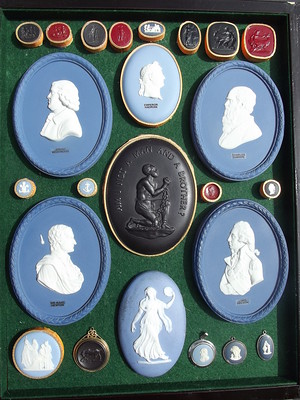
Plaster and Wedgwood Cameos
Jump back to Rome where the best seal carvers live and where the rich people are coming on The Grand Tour. A man named Paoletti has been collecting images from seals and he starts making copies of them out of a mixture of ground marble and Plaster of Paris. He puts these impressions in fake books and tourists buy them to take back to England. This is about 1820 now and he scraps the ground marble and uses only plaster of Paris. Some of these got framed and put on the walls of posh houses. People liked collections of things and businessmen such as Wedgwood made sets of images such as Kings of France and Kings of England. Art medals had become popular, but these were expensive. However, plaster copies of art medals were inexpensive and so people would collect plaster copies and frame them. These were usually made with a paper surround with a gilt edge so when you looked at a copy in a frame you saw the white plaster and a gold border. If you owned a large collection of things, you could make plaster copies and sell them. Early museums even allowed collectors to come in and make copies. You will not see that today.
Whitney Allen writes:
"Thank you! I've been thoroughly educated beyond my seemingly in-depth Google search! I was absolutely fascinated by the extensive information your readers were able to pass on! They truly encompass a wealth of knowledge. So happy to meet a diverse group of historians who are excited to teach and pass on pieces of the past! Blessings to you and each of them for taking time during such a hectic season to encourage my curiosity!"
Thanks, everyone! Great topic. -Editor
To read the earlier E-Sylum article, see:
QUERY: PLASTER MYSTERY MEDALS
(https://www.coinbooks.org/v23/esylum_v23n41a13.html)
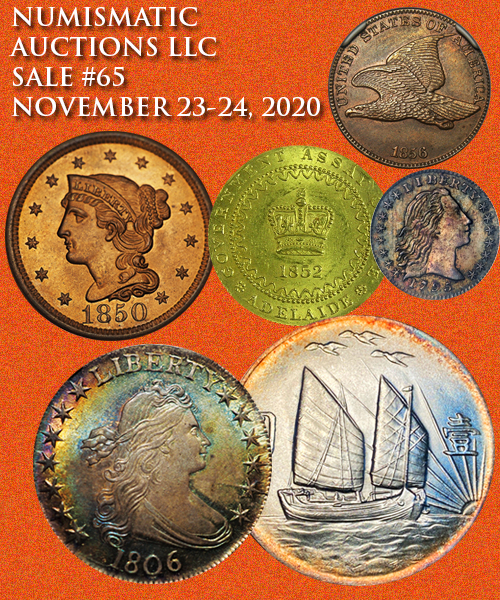
NOTES FROM E-SYLUM READERS: OCTOBER 18, 2020
The 1794 Starred Reverse Large Cent
Paul Horner writes:
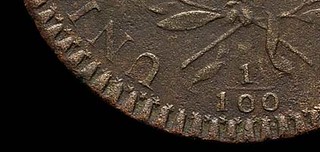 "You asked, 'Is there a U.S. Coin with more stars
than the Kennedy Half Dollar?'
"You asked, 'Is there a U.S. Coin with more stars
than the Kennedy Half Dollar?'
(One) Answer: YES! The 1794 Starred reverse Large Cent. Sheldon in Penny Whimsy says there are 94 Stars around the circumference."
Denis Loring writes:
"How about 1794 S-48, the beloved Starred Reverse LC? 94 stars!"
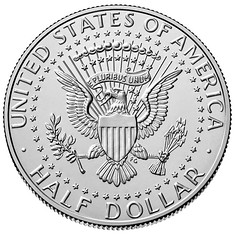
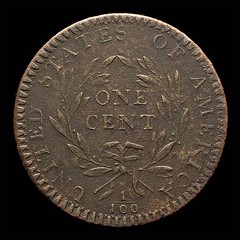
Why settle for 63 stars when you can have 94?
Well, duh! How could I have missed THAT one! Thanks! -Editor
To read the earlier E-Sylum article, see:
NOTES FROM E-SYLUM READERS: OCTOBER 11, 2020 : More Stars on United States Coinage
(https://www.coinbooks.org/v23/esylum_v23n41a12.html)
On Michael Collins, Queen Victoria and John Law
Levin Messick writes:
"I was happy to finally finish up a week of ConferZoom and grading Midterms for my appraisal classes at Glendale College. A really great thing about this is I see and interact with my students almost as well as being in front of them. Another great thing is that I do not have to make a 94 mile round trip from Orange County to the campus to teach. Ain't technology great?
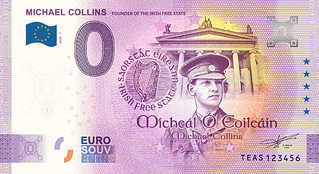 "I did not let any grass grow under my feet and immediately ordered the Michael Collins note shown in the newest newsletter. My Irish Grandmother was an admirer of this gentleman. She detested De Valera who she said could not wait to murder true Irishmen like Collins and take away the rights of women that had been granted them in Ireland's first Constitution.
"I did not let any grass grow under my feet and immediately ordered the Michael Collins note shown in the newest newsletter. My Irish Grandmother was an admirer of this gentleman. She detested De Valera who she said could not wait to murder true Irishmen like Collins and take away the rights of women that had been granted them in Ireland's first Constitution.
"Grandmother was among a group of young ladies who presented Queen Victoria with a basket of flowers during her 1900 Progress through Dublin. She said she ran like a wild gazelle, lost her patent leather shoes, and tore the bottoms from her best silk stockings to get there in time. She said the old queen smiled, waved, and stopped her carriage to speak to them. She said that she could not get over how tiny the queen was and that this lady ruled the greatest empire on earth and yet took time to stop and chat with a group of teenage schoolgirls. She also said that even the most confirmed Fenians cheered the "Dear Old Queen" She told the truth, there are nineteen reels of Pathe film showing the queen in Dublin. One of them shows that scene.
"My Grand Mom lived to watch men walk on the Moon. She was as my Grandfather once described her- "A force of nature". Oh, she loved to read and collected stamps, banknotes, and coins! She presented me with a complete set of Baden-Powell's Mafeking notes and stamps when I was a teenager. One of her relatives was a soldier at the siege and saved them for her. Ireland issued stamps for Collins some time back but no banknotes- so this will have to do.
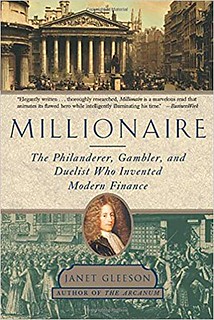 "The new book Money by Jacob Goldstein is on my list to get. I spent this month's "Mad Money" on several banknotes, several stamps and three books about John Law - They are Millionaire by Janet Gleeson, John Law of Lauriston by A.W. Wiston-Glynn, and John Law by James Buchan. My interest in this gentleman began when Ralph "Curly" Mitchell sold me a 1720 Banque de France note forty years ago.. So, I would add that Law also pretty much invented the concept of stocks and a stock market as well as the concept of issuing paper currency up to the limit of a nation's "Gross National Product". Have you heard that phrase before? I believe Law invented it. The 1368 Ming notes, the 1660's Swedish issues, the Massachusetts 1690's colonial issues, and these John Law notes are among the earliest collectable paper money. "
"The new book Money by Jacob Goldstein is on my list to get. I spent this month's "Mad Money" on several banknotes, several stamps and three books about John Law - They are Millionaire by Janet Gleeson, John Law of Lauriston by A.W. Wiston-Glynn, and John Law by James Buchan. My interest in this gentleman began when Ralph "Curly" Mitchell sold me a 1720 Banque de France note forty years ago.. So, I would add that Law also pretty much invented the concept of stocks and a stock market as well as the concept of issuing paper currency up to the limit of a nation's "Gross National Product". Have you heard that phrase before? I believe Law invented it. The 1368 Ming notes, the 1660's Swedish issues, the Massachusetts 1690's colonial issues, and these John Law notes are among the earliest collectable paper money. "
Thanks! What a life your Grandmother had! -Editor
To read the earlier E-Sylum articles, see:
INTERVIEW: 'MONEY' AUTHOR JACOB GOLDSTEIN
(https://www.coinbooks.org/v23/esylum_v23n41a06.html)
IRISH MICHAEL COLLINS SOUVENIR BANKNOTE
(https://www.coinbooks.org/v23/esylum_v23n41a28.html)
Dan Carr 2020 COVID-19 Token Available Again
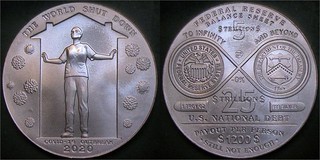 Adam Spikes writes:
Adam Spikes writes:
"Some of the readers of The E-Sylum may be interested in knowing the Daniel Carr 2020 COVID-19 Outbreak Hard Times Token is again available. Just got mine!"
Thanks. -Editor
To read the earlier E-Sylum article, see:
NOTES FROM E-SYLUM READERS: OCTOBER 11, 2020 : 2020 Covid-19 Outbreak Hard Times Token
(https://www.coinbooks.org/v23/esylum_v23n41a12.html)

COINHUNTING IN SPANISH FLEAMARKETS
Gary Beals of Segovia, Spain submitted this report on his recent activities and included are photos of coinsellers in 1970s fleamarkets. Thanks! -Editor
This year, along with the convulsions of the pandemic has pulled me away from coins and back to photography. We numismatists often have other interests and specialties in our lives. This year marks 50 years since I was taking photographs in Spain in 1970 and the city hall of Segovia and the local photo association invited me to exhibit some 55 photos from that period.
Back then I was a U.S. Air Force captain newly assigned to three years in Spain. (I had volunteered to go to Vietnam and orders were being cut — then the Air Force noted that I spoke some Spanish and asked me if I might prefer three years in Spain to one in Southeast Asia. Thanks to an early fascination with Latin American coins, I made a coin hunting trip to South America at age 16 and got a second language ability underway.)
While in Madrid and Zaragoza I traveled around Spain while it was still almost a third world nation. my photography and coins only crossed as I photographed Madrid's famous Rastro fleamarket in 1970. Coins real and fake appeared there in gritty bowls laid out along with keys, knives, jewelry and junk. So we would hunker down and paw through the pieces.
Today the nearby Plaza Mayor is the more sophisticated site with dealers in coins, stamps and small collectables every Sunday — now pending re-opening thanks to Covid 19.
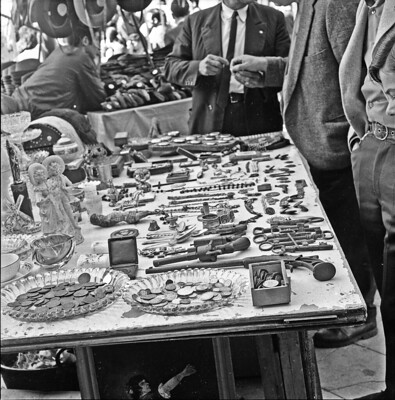
Bowls of coins were part of the inventory at Madrid's Rastro fleamarket.
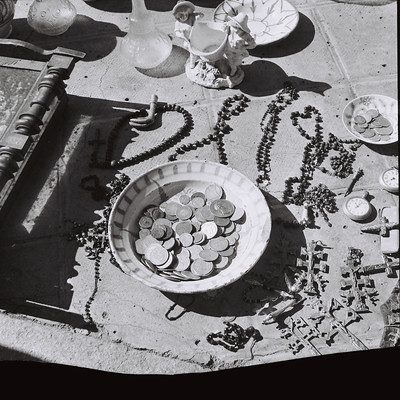
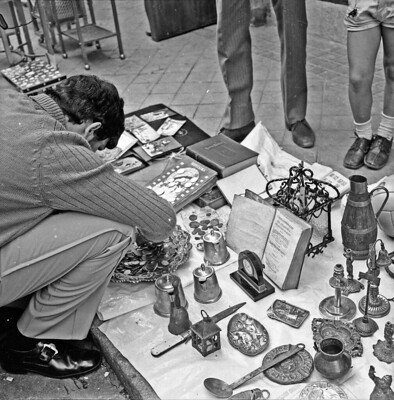
A young collector checks out a tray of coins in 1970
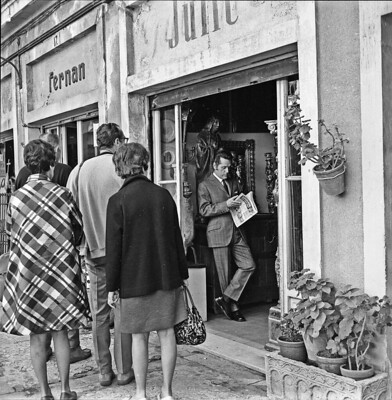
Dapper antiques dealer catches up on the news while waiting for customers. "Coins? No, I don't have any dang coins!"
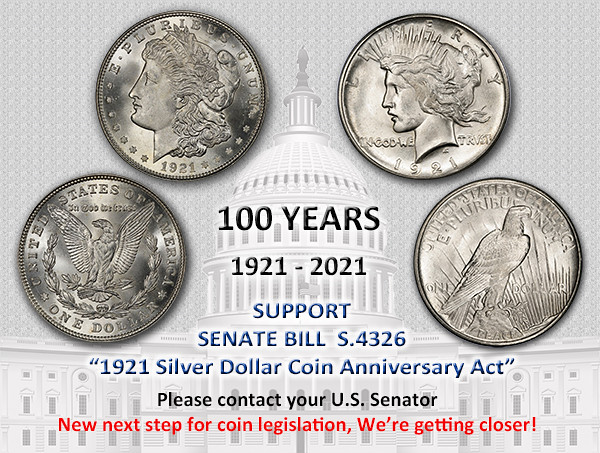
EDWIN JOHNSTON'S AI MONEY ART DESIGNS
Edwin Johnston submitted these comments regarding my 2020 Newman Numismatic Portal Symposium talk on The Money Art of J.S.G. Boggs. Thanks. -Editor
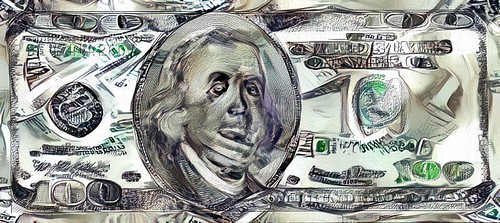
Thanks for the great presentation on the life of JSG Boggs. As a fan of Boggs and other money artists and minters I enjoyed your personalized tales. I've got a set of his orange plastic Sacagawea dollars. I like that you formed your relationship through your interest in books and became interested in fine art collecting.
What impressed me most in your presentation was the hand drawn bill Boggs made you and the level of enthusiasm he put behind it.
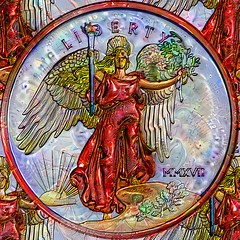 I wrote to Daniel Carr, another money artist, the other day since we hadn't corresponded in a few years. We're all in the same age group.
One thing I never see mention of about JSG Boggs is that an historical antecedent was Yves Klein who sold "disappearing" gold flake to a collector that Klein then threw in the Seine River.
I wrote to Daniel Carr, another money artist, the other day since we hadn't corresponded in a few years. We're all in the same age group.
One thing I never see mention of about JSG Boggs is that an historical antecedent was Yves Klein who sold "disappearing" gold flake to a collector that Klein then threw in the Seine River.
I've attached a couple of my own recent money art designs that I alter with the aid of artificial intelligence. I mostly use coins but had recently done this bill before seeing your presentation.
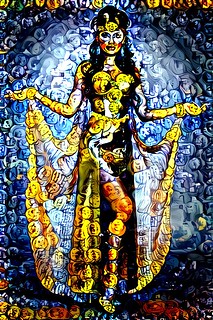 Now I'm getting too old and sick to participate in the hobby as actively as I once did. For instance, I have cataracts and can't get surgery due to more serious issues.
Now I'm getting too old and sick to participate in the hobby as actively as I once did. For instance, I have cataracts and can't get surgery due to more serious issues.
I use https://deepdreamgenerator.com/ online for the artificial intelligence enhancements. It can map aspects of one image onto another one. Beyond a simple once-through enhancement I use the GIMP2 photo editing program to play with masking and other manipulations. I typically build an image up using a process of 100 layers taking me a full day's work and concentration.
I've included a few more designs for illustration, including a woman model that I enhanced to be made of coins themselves.
That's a lot of work! Here are more of Edwin's images. Great fun. Thanks! These are some attractive designs. -Editor

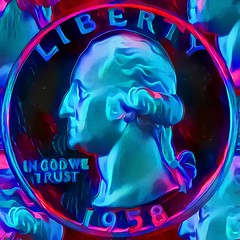
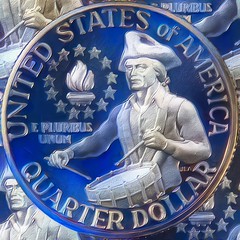
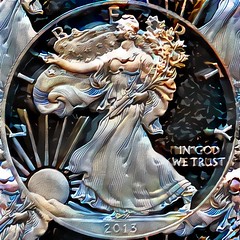
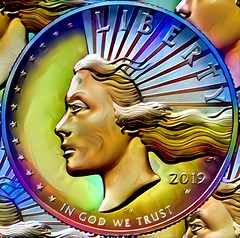
To watch the complete presentation, see:
The Money Art of J.S.G. Boggs
(https://nnp.wustl.edu/library/book/588177)

VOCABULARY TERM: PRIVATE MINT
Dick Johnson submitted this entry from his Encyclopedia of Coin and Medal Terminology. Thanks. -Editor
Private Mint. A nongovernment mint. A private manufacturer with blanking, coining and die-making equipment to custom produce coins, tokens and small medals for anyone. Private mints have been established in countries of high industrial activity: Great Britain, Germany, Belgium, Spain, Sweden, Switzerland, and the United States. The term "mint" in the term implies the manufacture of coins, requiring the use of coining presses. But these same coining presses can also strike tokens – and medals like coins (see coin-medal). To keep their presses busy, private mints frequently strike noncoin items. However, coining presses cannot strike pieces larger than, say, two inches; thus private mints generally do not have the capacity for large medal manufacturing. This is the specialize activity of medal makers (see medal manufacturing).
Private mints have never replaced national mints (governments closely guard this exclusive right to strike their own coins). However private mints have rendered services, like supplying roll strip or blanks, to national mints in times of need. Only in the 20th century have private mints taken on a marketing activity to sell direct to the public the coins, medals and tokens they produce.
History of private mints. The first such private mint was Matthew Boulton's Soho Mint in Birmingham, established in 1788. In the 1760s Boulton developed an engine business based upon the inventions of James Watt. Once this business was running smoothly Boulton sought other ventures involving machinery that could run off his steam powered engines. He made experiments with die stamping, establishing, in 1782, a shop for diestamping and a button factory. He struck some prototype coins as early as 1786.
There was a shortage of copper coinage in England at the time and Boulton developed a plan for striking coins to relieve the shortage. To implement this plan he established the Soho Mint. He hired Jean-Pierre Droz (1746-1823), a Swiss engraver working at the Paris Mint, built a building and filled it with machinery run by his engines. He didn't get the contract to strike coins for the sovereignty, but he did strike coins for countries (Bahamas) and tokens for the merchants of England. In 1805 this early effort failed but some of the equipment was obtained by the son of his old partner, James Watt, who had established a mint under this name. And some was obtained by Ralph Heaton, who, in 1819 established the Heaton Mint. The later flourished and has been called The Birmingham Mint, or simply, The Mint, ever since.
While the Birmingham Mint dominated private custom coining for a century, some German firms were very active. Berlin's Oertel not only struck coins, but medals of all sizes, and tokens as well. Here are some notable private mints and their marks:
| Name, Location | Mintmark | Active Period |
|---|---|---|
| Ackroyd & Best Ltd., Morley, England | A | 1920 |
| Argor S.A. Lavorazione, Switzerland | ARGOR | 1961-date |
| Birmingham Mint, Birmingham | H | 1819-date |
| Boulton's Soho Mint, Birmingham | K, SOHO | 1788-1806 |
| Central American Mint Ltd.,San Salvador | CAM | 1892-94 |
| Franklin Mint, Media, Pennsylvania | FM | 1965-89 |
| J.R. Gaunt, Birmingham | G | 1920 |
| Heaton Mint, Birmingham | .H, HEAT0N | 1819-date |
| Hirsch Messing und Kupfewerke, Berlin. | A | 1901 |
| Huguenin Freres, Le Locole, Switz | HUGUENIN | 1868-date |
| King's Norton, Birmingham | KN | 1919-72 |
| Krupp, Berlin | 1894 | |
| Lauer, Nuremburg | V | 1888-1918 |
| John Milton, London | M | 1788-92 |
| Oertel (Berliner Medaillen-Munze Otto Oertel), Berlin | OERTEL | 1892-1910 |
| Oeschger-Merdoch, Barcelonia | OM | 1865-90 |
| Pobjoy Mint, Ltd, Sutton, England | ||
| Poissy, France | (Thunderbold) | 1924-25 |
| Sproong, Sweden | ||
| Stora Kopparbergs-Bergslag, Sweden | 1719-91 | |
| Sunshine Mint, Hayden Lake, Idaho | ||
| James Watt & Co., Birmingham | W | 1786-1905 |
| Wolschot, Antwerp | R | 1814 |
| Wyon Private Mint, London | WW | 1843 |
Looking for the meaning of a numismatic word, or the description of a term? Try the Newman Numismatic Portal's Numismatic Dictionary at: https://nnp.wustl.edu/library/dictionary
Or if you would like a printed copy of the complete Encyclopedia, it is available. There are 1,854 terms, on 678 pages, in The Encyclopedia of Coin and Medal Technology. Even running two a week would require more than 19 years to publish them all. If you would like an advance draft of this vital reference work it may be obtained from the author for your check of $50 sent postpaid. Dick Johnson, 139 Thompson Drive, Torrington, CT 06790.
CHARLES GRAY (1696-1782)
John Lupia submitted the following information from the online draft of his book of numismatic biographies for this week's installment of his series. Thanks! As always, this is an excerpt with the full article and bibliography available online. This week's subject is Roman coin collector Charles Gray. -Editor
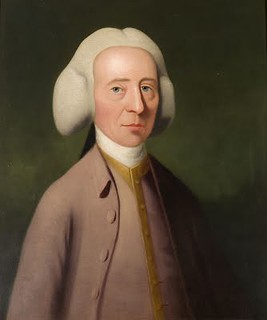 Charles Gray (1696-1782), was born at Colchester, England, son of George Gray, a glazier, and his wife Elizabeth.
Charles Gray (1696-1782), was born at Colchester, England, son of George Gray, a glazier, and his wife Elizabeth.
He studied at Cambridge University and he studied law at Gray's Inn becoming a barrister in 1724.
He was a classicist and trustee of the British Museum.
He donated a collection of Roman coins to the Philadelphia Public Library. The coins were received by Thomas Penn and given to the Library.
He died September 12, 1782 at Colchester, England.
To read the complete article, see:
GRAY, CHARLES
(http://www.numismaticmall.com/numismaticmall-com/gray-charles)
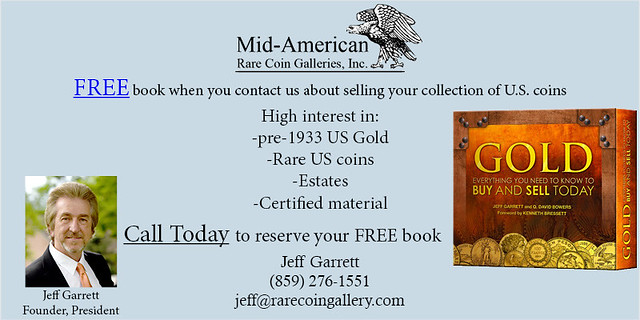
THE PAN FALL 2020 SHOW WILL TAKE PLACE!
At a time when one large or midsized show after another has been cancelled due to the coronavirus pandemic, it's news when one is NOT cancelled. The upcoming Pennsylvania Association of Numismatists (PAN) Fall show is taking place as planned, and will be one of the largest shows yet to resume. Naturally, as Ben Franklin notes, "Plague precautions shall be observed."
PAN Corresponding Secretary Pat McBride provided the following announcement. -Editor
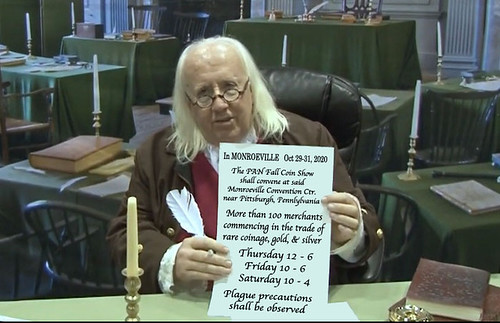
PAN FALL COIN SHOW
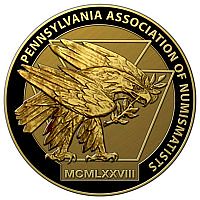 The October 29 – 31, 2020 Pennsylvania Association of Numismatists (PAN) Fall Coin Show will
take place as planned at the Monroeville Convention Center, a Pittsburgh PA suburb. Covid-19
guidelines will be observed including a daily health form questionnaire, temperature check,
mask wearing, hand sanitizing, and social distancing. These event guidelines must be agreed to
by PAN in order to use the convention center. It is our hope that dealers and attendees will
demonstrate patience and understanding as we navigate through this pandemic.
The October 29 – 31, 2020 Pennsylvania Association of Numismatists (PAN) Fall Coin Show will
take place as planned at the Monroeville Convention Center, a Pittsburgh PA suburb. Covid-19
guidelines will be observed including a daily health form questionnaire, temperature check,
mask wearing, hand sanitizing, and social distancing. These event guidelines must be agreed to
by PAN in order to use the convention center. It is our hope that dealers and attendees will
demonstrate patience and understanding as we navigate through this pandemic.
PAN has borne a financial strain as many businesses have throughout the year. Dealer and public support will help us to continue our good numismatic work to support the hobby and the industry. PAN has very actively been at the forefront to keep Pennsylvania a rare coins and bullion tax free state since the mid 1980's. That has translated into many thousands of dollars of cost savings for collectors and investors. Our non-profit mission is to encourage all to delve into the world of numismatics for the history, artistic beauty, and profitability when approached in a learned manner. We kindly ask that you help us spread the word about our large regional coin show. With the increasing Fall Covid-19 spread, the PAN show could be the last one to occur for a while.
For more information, see the PAN website:
https://pancoins.org/
CAND CANCELS 2021 CONVENTION
Yet show cancellations continue, including Canada's 2021 CAND show. -Editor
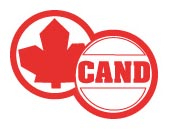 The January 2021 convention of the Canadian Association of Numismatic Dealers (CAND) has been cancelled due to the uncertainty surrounding the COVID-19 pandemic.
The January 2021 convention of the Canadian Association of Numismatic Dealers (CAND) has been cancelled due to the uncertainty surrounding the COVID-19 pandemic.
The annual harbinger of Canadian coin shows, the CAND Convention is held each January in Hamilton, Ont., where dozens of dealers from Canada and the United States gather for a two-day bourse and auction. But as the pandemic's “second wave” began in early October – and with the Canada-U.S. border closed for the foreseeable future – organizers were forced to put the brakes on next year's show, which was slated for Jan. 30-13, 2021.
“We certainly didn't want to take this action, but we had to make this decision sooner, rather than later, before the cancellation of our contract, without penalty, was in jeopardy,” said CAND President Michael Findlay.
The announcement – emailed to CAND's dealer members in mid-October – came about two weeks after the Ontario government implemented stricter public health measures as the province set a COVID-19 case record.
“With the current restrictions in and around the Toronto area of 10 people, with the prospect of this being in force for another month or more, it is only a matter of time before other large population centres, like Hamilton, Kitchener and London, become affected by the same limitations,” said Findlay, who also cited additional travel restrictions for travellers from the Maritimes and United States.
To read the complete article, see:
CAND cancels 2021 convention
(https://canadiancoinnews.com/cand-cancels-2021-convention/)
For more information on the Canadian Association of Numismatic Dealers, see:
https://www.cand.org/
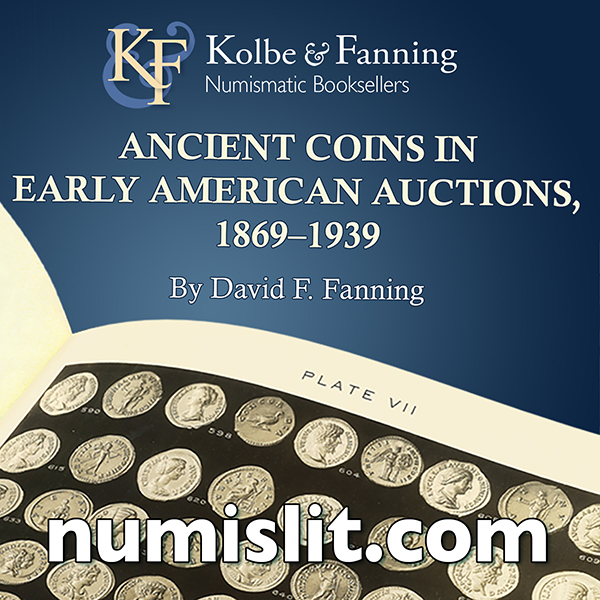
STEPHEN ALBUM RARE COINS AUCTION 38 RESULTS
The coin market is strong! Check out the results in the Stephen Album Rare Coins recent Auction 38. -Editor
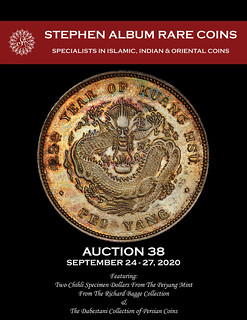 Stephen Album Rare Coins held its Auction 38 on September 24-27, 2020 at its offices in Santa Rosa, CA.
The continued strength of the market was shown as the auction far exceeded expectations. With a total
hammer price of $2.10 million (including buyer's fees), a new record was set for the firm, who had
broken their record total in their previous auction in June 2020. A sell-through rate of 94.5% for the floor
sessions further verified that collectors are clamoring for coins, with more and more coin sales across
the world being pushed to internet-based venues.
Stephen Album Rare Coins held its Auction 38 on September 24-27, 2020 at its offices in Santa Rosa, CA.
The continued strength of the market was shown as the auction far exceeded expectations. With a total
hammer price of $2.10 million (including buyer's fees), a new record was set for the firm, who had
broken their record total in their previous auction in June 2020. A sell-through rate of 94.5% for the floor
sessions further verified that collectors are clamoring for coins, with more and more coin sales across
the world being pushed to internet-based venues.
Many items went for multiples of their estimates, including the following (prices include buyer's fees):
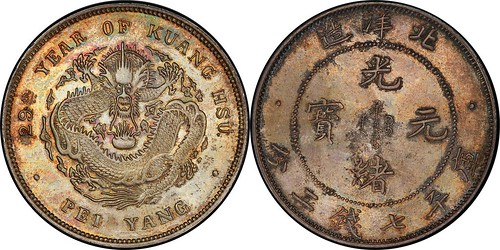
LOT 1169. CHINA: CHIHLI: Kuang Hsu, 1875-1908, AR dollar, Peiyang Arsenal mint, year 29 (1903), Y-73, L&M-462, with deep original color and iridescent rainbow toning on obverse, NGC graded Specimen 65, RRR, ex Richard Bagge Collection. Estimate: $60,000 - 80,000. Realized $202,300.
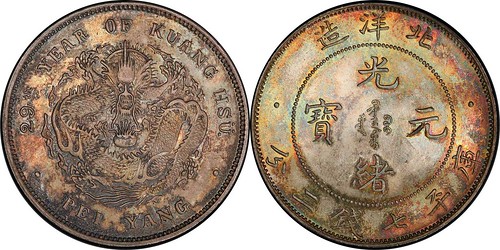
LOT 1170. CHINA: CHIHLI: Kuang Hsu, 1875-1908, AR dollar, Peiyang Arsenal mint, year 29 (1903), Y-73, L&M-462, with deep original color and iridescent rainbow toning on reverse, NGC graded Specimen 64+, RRR, ex Richard Bagge Collection. Estimate: $50,000 - 70,000. Realized $166,600.
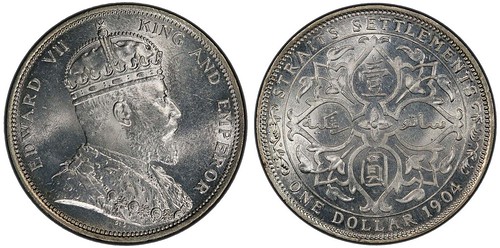
LOT 1523. WORLD: STRAITS SETTLEMENTS: Edward VII, 1901-1910, AR dollar, 1904-B, KM-25, Prid-4, radiant luster on a mirror-like surface, a superb example with tremendous eye appeal, the highest graded example by PCGS and tied with 4 examples by NGC, PCGS graded MS65. Estimate: $300 – 400. Realized $19,040.
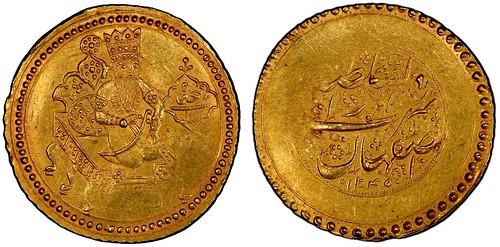
LOT 659. ISLAMIC: QAJAR: Fath ‘Ali Shah, 1797-1834, AV presentation toman (4.59g), Isfahan, AH1245, A-2871, KM-763, portrays the king seated on throne, with medallion bearing the ruler's name to the left // mint & date in fancy border, a superb quality example! PCGS graded MS62 (Gold Shield NFC Secure Holder), RRR, ex Dabestani Collection. Estimate: $3,000 - 4,000. Realized $11,305.
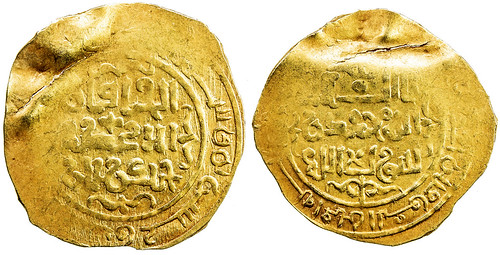
LOT 509. ISLAMIC: GREAT MONGOLS: Chingiz Khan, 1206-1227, AV dinar (3.56g), MM, AH62x, A-1964, obverse legend includes his name, al-khaqan / al-a'zam / chingiz khan, with the kalima in the reverse field; the reverse margin text presumably cites the Abbasid caliph, but only the words amir al-mu'minin are legible; some flatness and flan split, unpublished and presumably unique, VF-EF, RRRR. Estimate: $3,250 - 4,000. Realized $7,735.
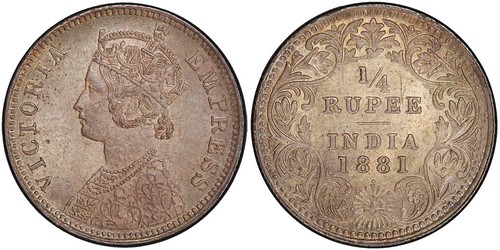
LOT 893. INDIA: BRITISH INDIA: Victoria, Empress, 1876-1901, AR 1/4 rupee, 1881(b), KM-490, S&W- 6.260 (dot), variety with dot, shimmering old cabinet tone, PCGS graded MS64. Estimate: $400 – 600. Realized $5,950.
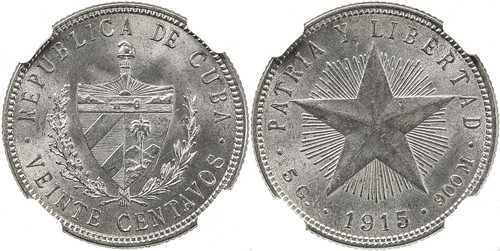
LOT 1896. WORLD: CUBA: Republic, AR 20 centavos, 1915, KM-13.1, high-relief star, coarse reeding, well struck with nice luster, rare variety, NGC graded MS63, R. Estimate: $900 - 1,100. Realized $5,950.
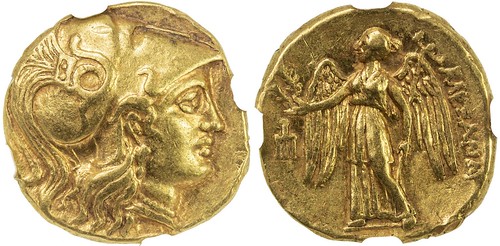
LOT 8. ANCIENTS: MACEDONIAN KINGDOM: Alexander III, the Great, 336-323 BC, AV stater (8.52g), Price-172, early posthumous issue, head of Athena right, wearing Corinthian helmet decorated with coiled serpent // Nike standing left, holding wreath in right hand and cradling stylis in left arm, downward trident head in left field, ALEXANDROU, edge marks, Strike: 5/5, Surface: 3/5, NGC graded choice EF. Estimate: $2,200 - 2,500. Realized $5,652.50.
Founder Steve Album was happy with the results. “While all areas did well, the Chinese and World sections far exceeded our expectations.”
The firm is currently taking consignments for its Auction 39 through November 1. That sale will be held January 21-23, 2021. You can visit the firm's website www.stevealbum.com for more information.
To read the earlier E-Sylum article, see:
STEPHEN ALBUM RARE COINS AUCTION 38
(https://www.coinbooks.org/v23/esylum_v23n36a19.html)
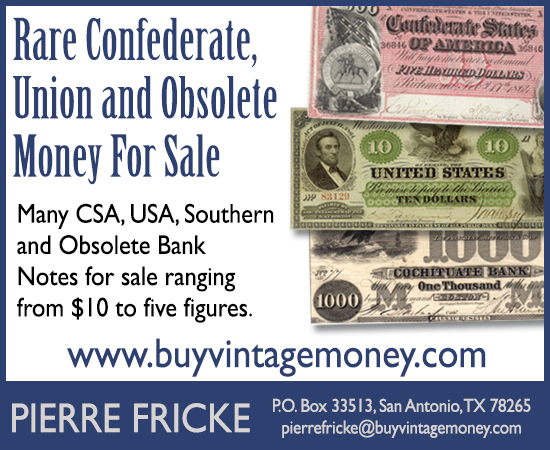
GOLDBERG AUCTIONS SOFAER PALESTINIAN RESULTS
Here are some strong sale results from the recent Goldberg's sale. -Editor
Prices Soar in Goldberg Auction of Abe Sofaer's Palestinian Rarities
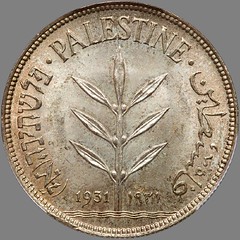
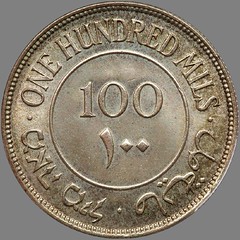
The star performer among the more than 40 lots of Abe Sofaer's Palestine Mandate coins in Goldberg's September 15-16 auction was the unique finest known 1931 100 Mils PCGS-MS-64. It was described as “Satiny white, near-gem surfaces, with attractive golden patina around devices and inscriptions. In our opinion, this is a full gem specimen and should be graded a point higher.” The hammer-price was $25,000 - 5 times the $5,000 estimate. Two other coins that were both tied for finest known, were the 1931 50 Mils PCGS MS-64, described as “An awesome coin [with] satiny surfaces covered by dazzling gold and peacock- green iridescence,” bringing $5,250; and the 1940 20 Mils PCGS MS-65, “Lovely example, with satiny mint bloom,” bringing $3,200. All of these, no doubt, are destined for Registry Sets.
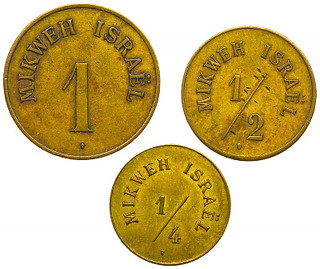 Not to be outdone by the popularity of Sofaer's Palestine Mandate coins, were
rare groups of Palestine-era tokens used in the Holy Land- where lot after lot
greatly outperformed the estimates. A partial set of Jerusalem Hotel Tokens c.
1880s, containing brass 1 and 1/4 Piaster, EF, brought $8,750 (est. $1,000 up); a
complete set of Templar Tokens c. 1880-1917, Avg. Fine, sold for a strong $5,000
vs. the estimate of $250-$300; and a complete set of Mikveh Israel Tokens c.
1885, VF – AU, was hammered down for an impressive $13,000, dwarfing the
$2,000 estimate.
Not to be outdone by the popularity of Sofaer's Palestine Mandate coins, were
rare groups of Palestine-era tokens used in the Holy Land- where lot after lot
greatly outperformed the estimates. A partial set of Jerusalem Hotel Tokens c.
1880s, containing brass 1 and 1/4 Piaster, EF, brought $8,750 (est. $1,000 up); a
complete set of Templar Tokens c. 1880-1917, Avg. Fine, sold for a strong $5,000
vs. the estimate of $250-$300; and a complete set of Mikveh Israel Tokens c.
1885, VF – AU, was hammered down for an impressive $13,000, dwarfing the
$2,000 estimate.
All of Sofaer's Palestinian coin and token lots are pictured and described, along with the prices realized, at www.goldbergcoins.com.
ARCHIVES INTERNATIONAL AUCTION 62
Here is the announcement for the October 29, 2020 sale by Archives International Auctions. Great material! -Editor
HISTORIC AND UNIQUE CIRCA 1820-1824, TENNESSEE OBSOLETE BANKNOTE COPPER PRINTING PLATE ENGRAVED BY WILLIAM KNEASS, THE SECOND CHIEF ENGRAVER OF THE U.S. MINT, OFFERED AT ARCHIVES INTERNATIONAL'S OCTOBER 29, 2020 AUCTION
The auction will be held by Archives International Auctions at their offices in River Edge, N.J.
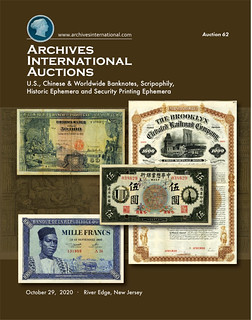 The October 29, 2020 auction by Archives International Auctions will also
consist of 962 lots offered over 1 day beginning with 333 lots of Worldwide and Chinese Banknotes . The World Banknotes will be followed by 535 lots of U.S. & World Scripophily and an additional 94 lots of U.S. Banknotes , Security Printing Ephemera and Historic Ephemera.
The October 29, 2020 auction by Archives International Auctions will also
consist of 962 lots offered over 1 day beginning with 333 lots of Worldwide and Chinese Banknotes . The World Banknotes will be followed by 535 lots of U.S. & World Scripophily and an additional 94 lots of U.S. Banknotes , Security Printing Ephemera and Historic Ephemera.
“During this difficult time period for our country and the world, we are striving to offer our clients and friends items of historical and collecting interest that have been off the market for decades or are new to the collecting world. We hope this auction will add a small amount of enjoyment to everyone's lives”, stated Dr. Robert Schwartz , President of Archives International Auctions. “Included in the upcoming auction is a wide variety or rare, interesting and desirable numismatic and historical objects to enhance the collections of every level of collector and dealer”.
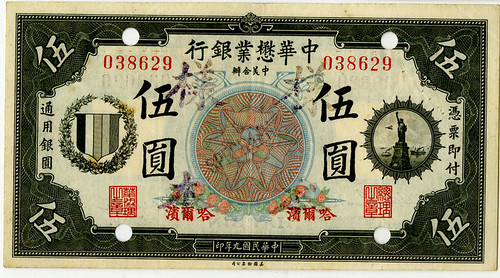
Lot 91: Chinese-American Bank of Commerce, $5, Specimen
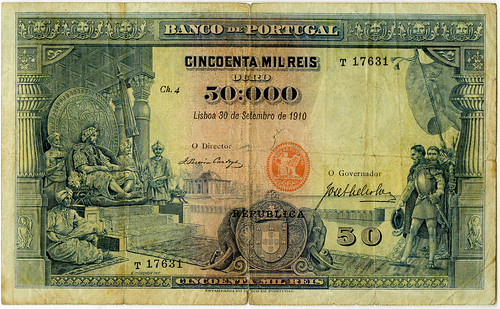
Lot 275: 1917 Banco de Portugal 50 Mil Reis
The auction begins with a large group of consignments from numerous estates and longtime collections with many rare notes having never been offered previously at auction. Included is a wide selection of worldwide notes with many highlights including 3 exceptional Angola notes of two specimens, tied with the finest known examples from the 1970 issue as well as an unlisted Essay design of a ca.1920 proposed note by the Swiss security printer “OFZ”. An exceptional offering of Chinese rarities is also offered and is highlighted by numerous rare notes including an exceptional 1920, Commercial Bank of China , 10 Tael Specimen note, the highest graded example in the PMG census; an extremely rare high grade 1917, Bank of China, $1, Tientsin Branch Issue Specimen; an amazing 1920, Chinese-American Bank of Commerce, $5, “Harbin” Branch Issue Specimen rarity, possibly unique; also, there are a number of provincial bank rarities including a 1907, Kiangnan Yu-Ning Government Bank, “1 Dollar” Issue with only 2 examples listed in the PMG Census; France is represented by an extremely rare 1796, Mandats Territoriaux issue note which is the only graded example in the PMG census as well as a 1797 Tresorerie National, Recepisse that is rarely seen in auction; the auction includes 40 lots of German issues and Notgeld; Portugal is represented by a number of rare notes including a Banco de Portugal , 1917, 50 Escudos note and literally hundreds of additional and desirable banknotes from nearly every country around the world.
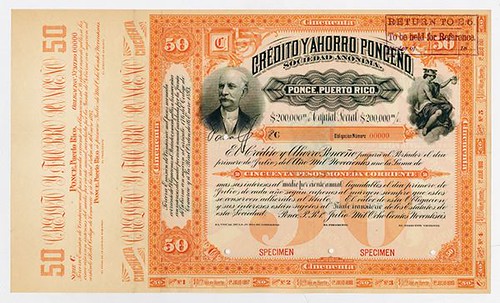
Lot 476: 1893 Puerto Rico Moneda Corriente Bond
The world notes are followed by 533 lots of U.S. and World Scripophily beginning with automobile and aviation bonds and shares followed by banking, finance and insurance bonds and shares. Internet and technology companies include certificates from Yahoo! and eBay ; followed by numerous communication and telephone company related lots and an outstanding Blackwell's Durham Tobacco Co., ca.1890s Specimen stock certificate. The World scripophily section includes 84 lots from numerous countries highlighted by a pair of early 1893 and 1897 Puerto Rico Specimen Bonds ; a new find of 21 Republic of Bolivia Issued and Uncancelled 1928 Gold bonds; 3 different 1896 to 1915 Russian Bond Specimens; and dozens of additional issued and specimen bonds.
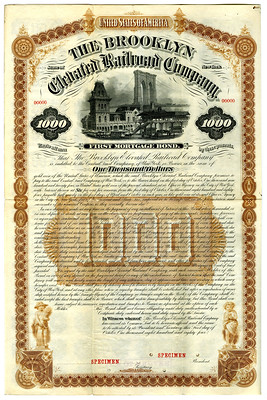 Mining bonds and shares are represented by 5 different Alaska mining stock certificates ; an outstanding Bodie, California, 1897, Standard Consolidated Mining Company is offered; an 1841 Maryland Mining Company rarity; and an 1869, Colorado Territory, Franklin Silver Mining Company bond, signed by B. Franklin Fisher, a Civil War Military hero who was the last surviving escapee from the notorious Libby Prison. This section of the auction finishes up with an outstanding collection of 24 different ca.1860's oil stock certificates from Pennsylvania, New York and West Virginia.
Mining bonds and shares are represented by 5 different Alaska mining stock certificates ; an outstanding Bodie, California, 1897, Standard Consolidated Mining Company is offered; an 1841 Maryland Mining Company rarity; and an 1869, Colorado Territory, Franklin Silver Mining Company bond, signed by B. Franklin Fisher, a Civil War Military hero who was the last surviving escapee from the notorious Libby Prison. This section of the auction finishes up with an outstanding collection of 24 different ca.1860's oil stock certificates from Pennsylvania, New York and West Virginia.
Railroads bonds and shares are offered in 234 exceptional lots of issued and specimen certificates with many rarities including a number that were previously unknown to the collecting community including this outstanding Brooklyn, New York Bond, “The Brooklyn Elevated Railroad Company” , 1884 Specimen. The scripophily section finishes with a group of early San Francisco and California Government bonds, circa 1858 to 1872; additional city and state bonds; Sugar companies and finally various utilities.
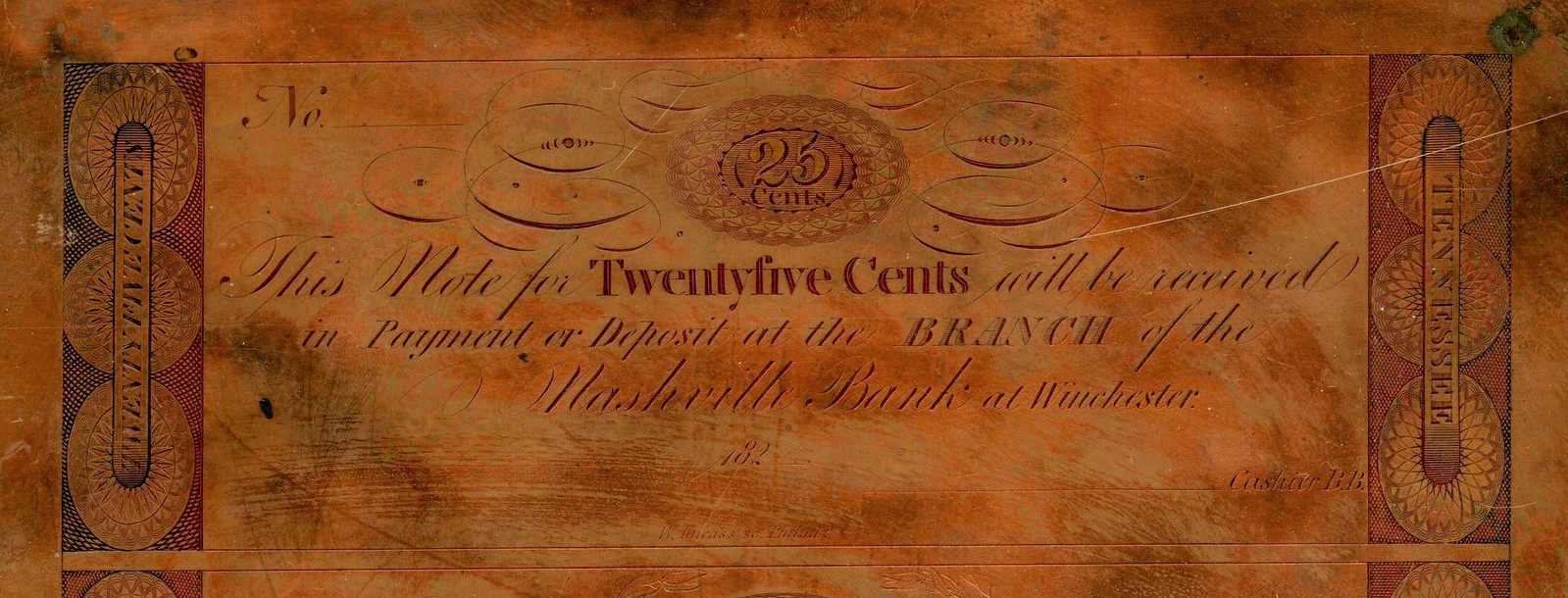
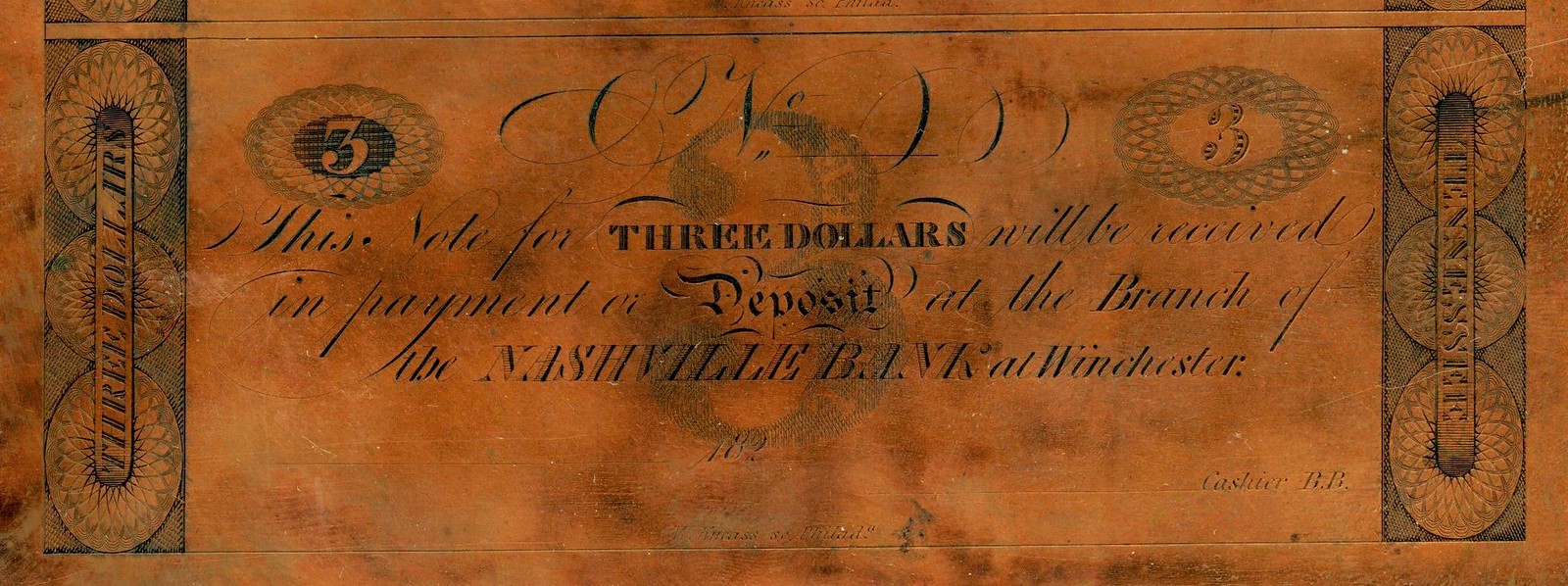

 The U.S. Banknote section includes Obsolete banknotes and Depression scrip and is highlighted by a historic and unique Nashville Bank at Winchester, Tennessee , 1820-24 Copper Obsolete Banknote printing plate of 5 subjects engraved by Willian Kneass, who in 1824 became the second Chief Engraver of the U.S. Mint. He was noted for designing the Classic Head Motif used on the $5 and $10 gold coins dated 1834 to 1839 as well as many other changes and additions to U.S. coinage of that era.
The U.S. Banknote section includes Obsolete banknotes and Depression scrip and is highlighted by a historic and unique Nashville Bank at Winchester, Tennessee , 1820-24 Copper Obsolete Banknote printing plate of 5 subjects engraved by Willian Kneass, who in 1824 became the second Chief Engraver of the U.S. Mint. He was noted for designing the Classic Head Motif used on the $5 and $10 gold coins dated 1834 to 1839 as well as many other changes and additions to U.S. coinage of that era.
The printing plate consists of the denominations of 25 Cents, 50 Cents, $1, $2 and $3 of an unlisted Tennessee obsolete banknote issue. Each note has engraved at the bottom “W. Kneass, Philadelphia. The printing plate was found in an old estate in Pennsylvania and is new to the collecting community and is sure to attract considerable interest from both banknote and coin enthusiasts. The auction ends with a large group of Historic and Security Printing Ephemera lots including dozens of desirable items seldom seen at auction.
Previews will be limited and by appointment only and we will be observing strict safety precautions including the wearing of masks and observing social distancing to protect our team as well as our guests. We will do our best to accommodate anyone who desires additional information and photographs. For questions, please call 201-944-4800 or email info@archivesinternational.com.
The online catalog for the October 29th auction is on Archives International Auctions' website and can be viewed via the Archives International live bidding platform. It can also be viewed as a Virtual Catalog or downloadable Sale 62 .pdf on our website. To pre-register for Live Internet Bidding, log on to the Archives International Auctions website, at www.ArchivesInternational.com.
Archives International is now working on their late Fall and early Winter 2020-21 auctions and are seeking quality consignments for future auctions or outright purchase including U.S. and worldwide banknotes, coins, stocks, bonds, stamps, postal history, historic ephemera, and autographs. To sell or consign one piece or an entire collection, please call AIA at (201) 944-4800; or e-mail them at info@archivesinternational.com.
You may also write to Archives International Auctions, at 1060 Main Street, River Edge, NJ 07661, U.S.A. To learn more about Archives International Auctions and the auctions planned for October 29th, 2020, log on to www.ArchivesInternational.com.
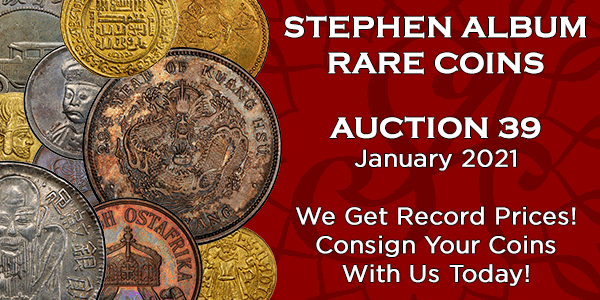
COLTRANE COLLECTION SELECTIONS: BACK DESIGNS
Stu Levine, Bruce Hagen, and Maureen Levine submitted this preview of paper money lots in the upcoming Heritage sale of the Mike Coltrane Collection -Editor
The Mike Coltrane Collection Part 1 Sale
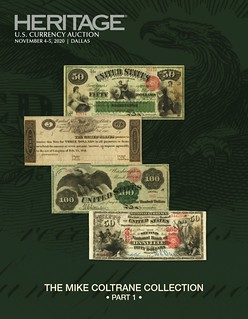 Currency collectors will find many fascinating notes in The Mike Coltrane Collection Part 1,
to be sold unreserved by Heritage Auctions on November 4–5, 2020. Many of these United
States currency notes, most of which have been off the market for decades and offered
certified for the first time, have interesting and often overlooked features.
Currency collectors will find many fascinating notes in The Mike Coltrane Collection Part 1,
to be sold unreserved by Heritage Auctions on November 4–5, 2020. Many of these United
States currency notes, most of which have been off the market for decades and offered
certified for the first time, have interesting and often overlooked features.
The Federal currency faces often spawn commonly used nicknames such as “Chiefs” and “Bisons.” Back design intricacies merit appreciation and study; some have nicknames such as “Poker Chip” and “Diamond Back.” The famous “Grand Watermelon” derives its nickname from its distinctively engraved “0” elements on the back. The Mike Coltrane Collection is laden with notes with well-engraved backs that are richly engraved, colorful, and historical.
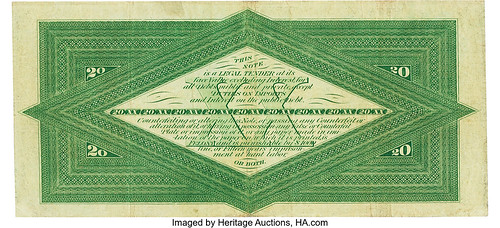
Fr. 197 $ $20 Act of March 3, 1863 One-Year 5% Interest Bearing Note Hessler X137B. PMG Choice Very Fine 35 An early “Diamond Back” motif dominates the center of this back. Later, the well-known horizontal diamond structure appeared on 1886 $20 Silver Certificates. Lot 25109.
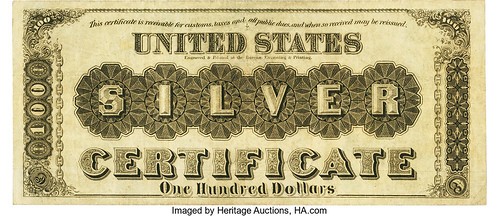
Fr. 341 $100 1880 Silver Certificate PMG Very Fine 30
This high denomination Silver Certificate back is printed in a distinctive brownish ink and
featuring a linear “SILVER” across. Lot 25159.

Danville, IL - $50 1875 Fr. 451 The Second National Bank Ch. # 2584 PMG Very Fine 30 The First Charter National Bank Notes arguably have the greatest backs used on American currency. The art was adapted from historical painting from the United States Capitol building. The Embarkation of the Pilgrims is based on Robert Weir's painting. Lot 25191.
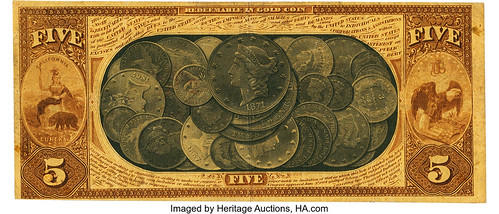
San Francisco, CA - $5 1870 Original Fr. 1136 The First National Gold Bank of San
Francisco Ch. # 1741 PMG Choice Very Fine 35
National Gold Bank Notes were printed on distinctive golden paper . The back of this “In
Gold Coin” payable series featured a uniquely styled array of various United State gold coins
(with an 1871 obverse on an 1870 dated note) engraved and printed with a "trompe l'oeil"
effect. Lot 25244.
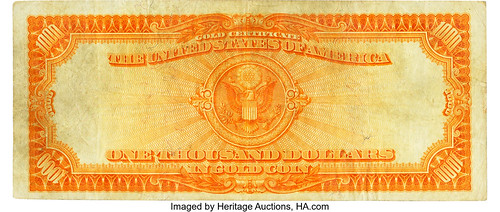
Fr. 1219e $1000 1907 Gold Certificate PMG Very Fine 30
Gold Certificates have eye-catching and often intensely orange back like this. Virtually all
“Gold Notes” have these colorful backs and most are quite affordable. Lot 25273.
All lots are currently on Heritage Auctions preview at HA.com/3575. The sale will be held in Dallas with Session 1 (floor) on November 4 and Session 2 (online only) on November 5. Lot viewing will be available by appointment only at Heritage's Office in Dallas (October 26- November 4); contact Jose Berumen at JBerumen@ha.com or 214-409-1299.
To read the earlier E-Sylum article, see:
COLTRANE COLLECTION SELECTIONS PART 1
(https://www.coinbooks.org/v23/esylum_v23n41a22.html)

NUMISMATIC NUGGETS: OCTOBER 18, 2020
Here's a selection of interesting or unusual items I came across in the marketplace this week. Tell us what you think of some of these. -Editor
1786 New Jersey Copper
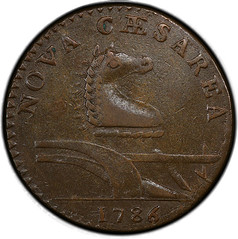
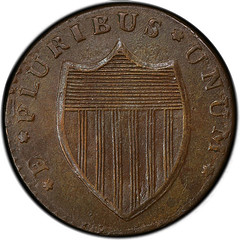
W-4810,R.1 *** Handsome first year of issue. Nice light brown color qualifies this coin as choice. Affordable grade with mint state costing double or triple.
Nice coin. I saw this one in the stock of Harry Laibstain Rare Coins. -Editor
To read the complete item description, see:
1786 NJERSY NARROW SHIELD, S W-4810,R.1 *** PCGS AU55BN
(http://hlrc.com/Inventory/CoinViewer?id=868897001&c=23)
Oval George Washington Portrait Medallion
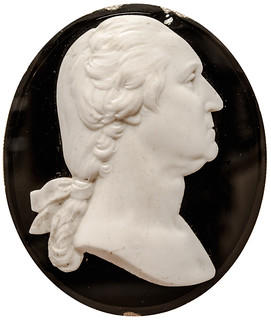
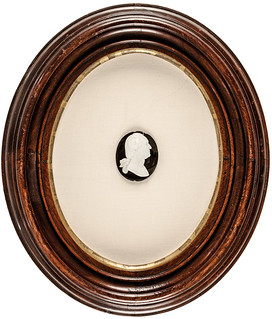
c. 1800s Classic George Washington Portrait Oval Medallion, Wedgewood Jasperware style, Framed, Extremely Fine.
This Wedgewood Jasperware style George Washington Portrait White Medallion measures about 1.75” x 2” and is housed in a 11.5” x 13.5”oval wooden frame. The central mounted Oval Medallion has a black background, itself mounted to a white linnen on board, with the contrasting white profile image of George Washington in relief under modern plexiglass. Some minor edge chips to the black mount portion at top and bottom.
Plaster medallions are discussed elsewhere in today's issue. This piece is in the October 31, 2020 Early American History Auctions sale. -Editor
To read the complete lot description, see:
Classic George Washington Portrait Oval Medallion
(https://www.earlyamerican.com/Auctions/ClientPages/lots.item.php?auction=10&lot=106)
1848 Will Page Medal
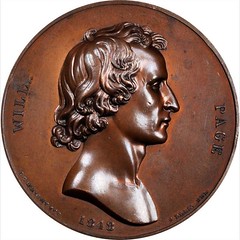
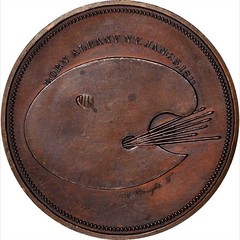
From the Stack's Bowers November 2020 auction. One of the benefits of collecting medals, tokens and other numismatica is the opportunity to learn about history and historical figures one might not otherwise come across. This medal celebrates artist Will Page with a bold obverse portrait and an unusually plain reverse picturing an artist's palette. -Editor
For more information, see:
William Page
(https://americanart.si.edu/artist/william-page-3665)
William Page (painter)
(https://en.wikipedia.org/wiki/William_Page_(painter))
To read the complete lot description, see:
1848 Will Page Medal. By Charles Cushing Wright. Julian PE-24. Bronze. Mint State.
(https://auctions.stacksbowers.com/lots/view/3-OOWSP/1848-will-page-medal-by-charles-cushing-wright-julian-pe-24-bronze-mint-state)
National Bank of Scotland Five Pound Note
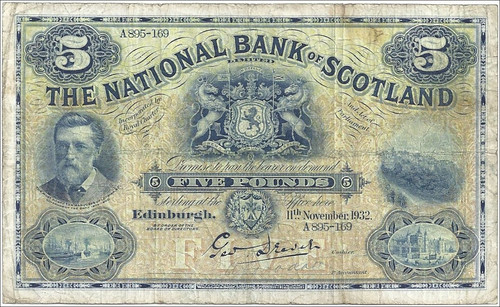
National Bank of Scotland
P253/NA36 £5 Drever/HS A First 11.11.32 GVG+ £270
Here's a note I came across in Pam West's A Bank Note Affair newsletter #167. -Editor
To visit Pam's website, see:
http://britishnotes.co.uk/
Macerated Money Postcards
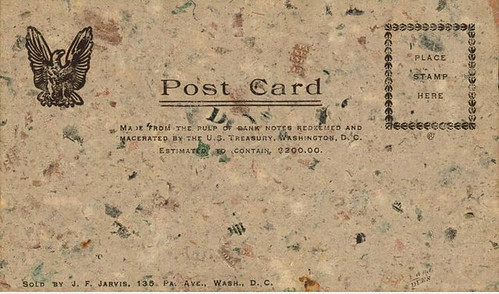
Eagle with raised wings left of POST CARD, stamp placement guide and text asserting that paper is made of redeemed and macerated banknotes estimated at $200.00. Five with PUBLISHED BY J.F JARVIS imprint, three with SOLD BY J.F. JARVIS imprint, and one with no imprint at all. The last card with no imprint has some ink writing over the stamp guide.
Provenance: From our (Coin Galleries') sale of December 2009, lot 1721.
A neat item of numismatic ephemera. I'd never seen these before. Also from the Stack's Bowers November 2020 auction. -Editor
To read the complete lot description, see:
Lot of (9) U.S. Eagle Macerated Money Postcards. Unusued. About Uncirculated.
(https://auctions.stacksbowers.com/lots/view/3-OOXY6/lot-of-9-us-eagle-macerated-money-postcards-unusued-about-uncirculated)
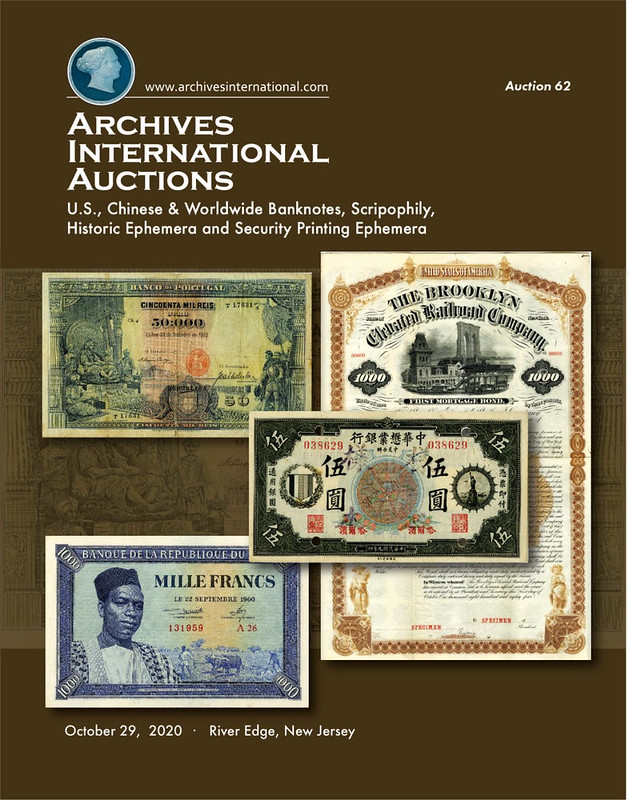
ANCIENT LIMESTONE TWO SHEKEL WEIGHT
It's not a coin, but Aaron Oppenheim passed along this article about the discovery of an ancient limestone two shekel weight discovered in Jerusalem's Old City. Thanks. -Editor
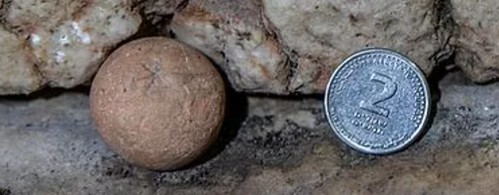
Archaeologists working on an excavation project in Jerusalem's Old City recently discovered a 2,700-year old limestone weight, which approximately correlated to the known weight of two shekels.
The weight - which derives from the Iron Age and coincides with the First Temple period - was retrieved during sifting of earthen fills from the City of David sifting project; conducted under the auspices of the Israel Antiquities Authority and in conjunction with the Western Wall Heritage Foundation beneath Wilson's Arch.
According to Dr Barak Monnickendam-Givon and Tehillah Lieberman, directors of the excavation on behalf of the Israel Antiquities Authority: “The weight is dome-shaped with a flat base. On the top of the weight is an incised Egyptian symbol resembling a Greek gamma (?), representing the abbreviated unit ‘shekel.' This weight weighs 23 grams and we know from earlier finds in Jerusalem that a single weight weighed 11.5 grams."
Using accurate weights was important for business during the First Temple period as coins were still not in use. At busy times of the year, such as the three pilgrim festivals (Passover, Shavuot and Sukkot) when Jerusalem would be full of people, being able to rely on an exact weight ensured that a system of barter and exchange continued to function.
To read the complete article, see:
First Temple period two shekel weight discovered in Jerusalem's Old City
(https://www.i24news.tv/en/news/culture/culture/1602574827-first-temple-period-two-shekel-weight-discovered-in-jerusalem-s-old-city)
DAVID VAGI GOLD IDES OF MARCH COIN INTERVIEW
Ancient coin expert David Vagi was interviewed by a Florida FOX affiliate about his work authenticating the gold EID MAR coin discussed last week. Here's an excerpt. See the complete article online. -Editor
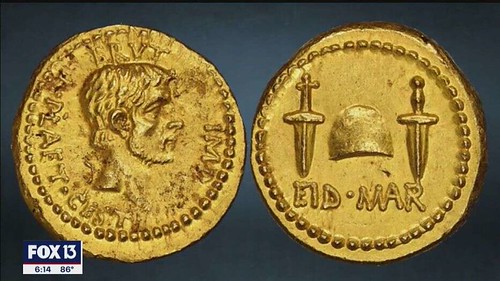
David Vagi has an eye for ancient coins. When one comes across his desk, he gets to work identifying and authenticating its worth and origin.
"The process is something that initially begins with a gut reaction to it," he said.
Recently, he was commissioned to verify an intricate, detailed gold coin that's only one of three in known existence.
"We ran some tests, compared dyes with other known examples in silver, we really went through a lot of effort to make sure every single detail was correct," he said.
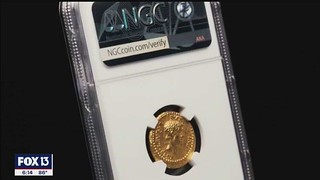 It's called "Edi Mar," or "Idea of March," and it stood out for all the right reasons.
It's called "Edi Mar," or "Idea of March," and it stood out for all the right reasons.
Vagi said every detail was there. The coin was minted by Julius Caesar's assassin, Brutus.
It's only one of three known to exist in gold.
"This transports you right back to the moment when this great event occurs, when Brutus is massing his armies to defend his cause," Vagi explained.
The coin is bold in its message.
"It was essential, the defense of the institutions of the republic that he felt were under threat by this dictator, Julius Caesar, and when you have a circumstance like that it's just hard to imagine in modern times how dramatic this was," he said.
It bears the image of Brutus himself, as he celebrated the murder of Caesar in 44 B.C.
"This is how we know what Brutus looked like," said Vagi.
The coin is now up for auction in London; a piece of history, that carries a story worth more than its weight in gold.
"A coin like this really exemplifies what's great about ancient coins, they're touchstones to these bygone civilizations. This coin, anyone at any point in history, be a king or a commoner, would have just loved to own this coin. It's really the most exciting roman coin in existence," said Vagi.
To read the complete article, see:
Sarasota numismatist verifies 'most exciting Roman coin in existence'
(https://www.fox13news.com/news/sarasota-numismatist-verifies-most-exciting-roman-coin-in-existence)
To read the earlier E-Sylum article, see:
GOLD IDES OF MARCH COIN OFFERED
(https://www.coinbooks.org/v23/esylum_v23n41a25.html)
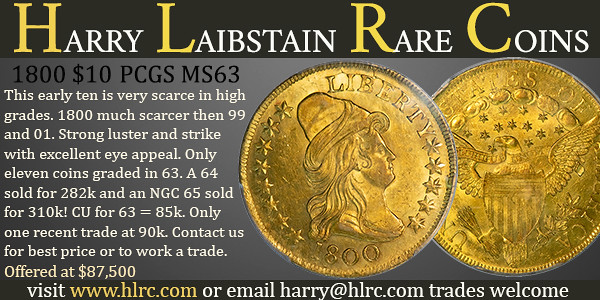
MEDIEVAL KILWA COINS DISCOVERED IN AUSTRALIA
The Express published a story about a confusing find of Tanzanian coins in Australia during WWII. Found via The Explorator newsletter. To subscribe to Explorator, send a blank email message to: explorator+subscribe@groups.io. -Editor

After Japanese bombers attacked Darwin, the Wessel Islands – off Australia's north coast – became a strategic position to help protect the mainland. Maurie Isenberg from the Royal Australian Air Force was stationed on one of the islands to man a radar station and spent his spare time fishing on the beaches. While sitting in the sand, he discovered a handful of coins – puzzled by them, he placed them in a tin and marked a map with an ‘X' to remember where he had found them.
It was not until 35 years later when he tried to sell the coins, that Mr Isenberg would become aware of the “treasure” he had found.
The coins proved to be 1,000 years old, and sparked the interest of the science community, including anthropologist Ian McIntosh – who dubbed them "priceless".
Prof McIntosh and his team of Australian and American historians, archaeologists, geomorphologists and Aboriginal rangers believed the five coins date back to the 900s to 1300s. The coins, believed to have originated in the medieval sultanate of Kilwa – an area which is now in Tanzania – led to speculation that parts of northern Australia were visited by other mariners from as far away as the Middle East and Africa.
Prof McIntosh wrote in a paper for the journal 'Australian Folklore,' that "the argument for the involvement of Kilwa traders and also the Portuguese is quite compelling".
While the theory could rewrite the history books, the academic admitted the coins may have simply washed ashore.
To read the complete article, see:
World War 2 'treasure map' tipped to rewrite history after experts left puzzled
(https://www.express.co.uk/news/world/1346273/world-war-2-archaeology-treasure-map-australia-wessel-islands-kilwa-coins-spt)
THE BOOK BAZARRE
ARTIST CREATES QATAR DEMONSTRATION DESIGNS
A Syrian artist living in Doha has created a set of demonstration coin designs for every ruler of Qatar since 1851. -Editor
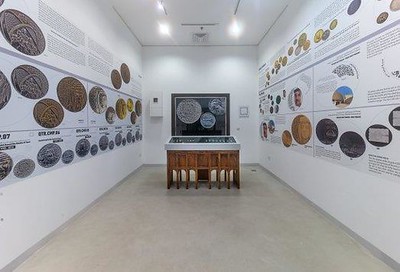 Since ancient times, coinage has played a significant role not only in the socio-economic aspect of civilisations as an instrument of business and trade but also in reflecting pivotal moments in a nation's history.
Since ancient times, coinage has played a significant role not only in the socio-economic aspect of civilisations as an instrument of business and trade but also in reflecting pivotal moments in a nation's history.
Coin denominations have been an invaluable source of facts such as in confirming dates and rulers, documenting specific events, and showing how structures actually appeared at a particular time in the past.
'When we talk about archaeology and anthropology, experts do need these coins in order to know more about civilisations because coins hold specific meanings in each civilisation. Coins reflect the social and industrial status as well as the rulers. They are a factual artefact for each civilisation; that's the real value of coinage, Qatar-based Syrian designer and artist Bachir Mohamad told The Peninsula.
Mohamad, who has a Bachelor's degree in Fine Arts and a Master's degree in Archaeology of Arab and Islamic World, has crafted a special collection of coins which reflect significant historical moments in Qatar tracing its rulers, their achievements and important events from 1851 to the present.
Through his collection, the artist imagines and demonstrates how the coins would appear had the country used them like in the Islamic caliphates of the past. The project also aims at providing informational value and dimension to revive the legacy of historical leading coins in the Arab and Islamic world.
The artist had spent two years to complete a series of nine coins which are being showcased to the public for the first time at a group exhibition called 'Process which is presented at Katara Art Center by Al Markhiya Gallery, the country's oldest privately owned art gallery.
To read the complete article, see:
Qatar- Documenting history through coinage
(https://menafn.com/1100867307/Qatar-Documenting-history-through-coinage)

CHRISTOPHER COLUMBUS: HIS DECLINE IN NUMISMATICS
Heinz Tschachler published a nice in-depth article on CoinWeek titled Christopher Columbus: His Decline in Numismatics and the Nation's Collective Memory . Here's an excerpt - see the complete article online. -Editor
When in the early 1990s the United States was getting ready to commemorate the quincentennial of Christopher Columbus first landing on the Caribbean island of Guanahani, a bill was proposed that would eliminate the cent and the half-dollar and create a new small dollar coin bearing a portrait of the discoverer (Wilcox, 1006-7).
Nothing ever came of this, though in November 1991 the United States Mint announced its plan for a “500 Years of Discovery Medal” for the U.S. Christopher Columbus Quincentenary Jubilee Commission. A year later, the Mint released a half-dollar commemorative coin. Designed by T. James Ferrell, the coin's obverse shows Columbus at landfall; in the background is the Santa Maria and a smaller ship with the crew disembarking. The coin's reverse shows Columbus' flotilla of three ships.
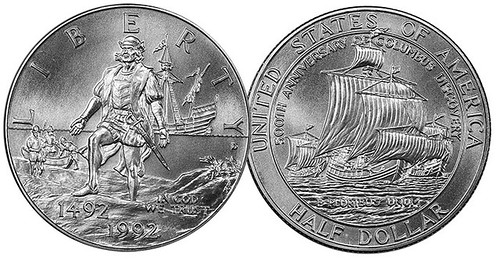
When in the early 1990s the United States was getting ready to commemorate the quincentennial of Christopher Columbus first landing on the Caribbean island of Guanahani, a bill was proposed that would eliminate the cent and the half-dollar and create a new small dollar coin bearing a portrait of the discoverer (Wilcox, 1006-7).
Nothing ever came of this, though in November 1991 the United States Mint announced its plan for a “500 Years of Discovery Medal” for the U.S. Christopher Columbus Quincentenary Jubilee Commission. A year later, the Mint released a half-dollar commemorative coin. Designed by T. James Ferrell, the coin's obverse shows Columbus at landfall; in the background is the Santa Maria and a smaller ship with the crew disembarking. The coin's reverse shows Columbus' flotilla of three ships.
Emitting the coins at best was a half-hearted endeavor, done in order not to fall behind international practice (Spain, Portugal, and Italy–as well as the Bahamas, Colombia, El Salvador, Costa Rica, Cuba, Jamaica, the Dominican Republic, and other Latin American countries already had produced their commemoratives).
Worse, sales figures were more than modest: of the six million pieces minted, only some 600,000 were sold to the public. Most of the coins were later melted down. The economic failure of the coin shows that in the United States there was not then much to write home about Columbus' numismatic presence, and the 1992 commemorative did little to improve the situation.
The quincentennial of Columbus' death, in 2005, did not occasion any numismatic activity on the part of the Mint, and the six-hundredth anniversary of Columbus' birth, presumably in 1451, seems too far in the future to make any predictions.
To read the complete article, see:
Christopher Columbus: His Decline in Numismatics and the Nation's Collective Memory
(https://coinweek.com/coins/commemoratives-coin-guide/christopher-columbus-his-decline-in-numismatics-and-the-nations-collective-memory/)
Tim Winkle of the Smithsonian's National Museum of American History published a related article on October 12, 2020. -Editor
In October 1792, the United States of America was still a new country, not even a decade old, fresh from a complete government overhaul just four years earlier. With only one federal election by that point, and one president, it was a nation long on ambition, but short on history. There were heroes, of course, drawn from the ranks of those who had struggled for independence from Great Britain. But Revolutionary heroes were growing politicized by 1792, taking sides in an emerging party system. What figure could rise above partisan squabbles to unite Americans in patriotic spirit? A New York merchant with a penchant for history and a budding fraternal organization had an answer: Christopher Columbus.
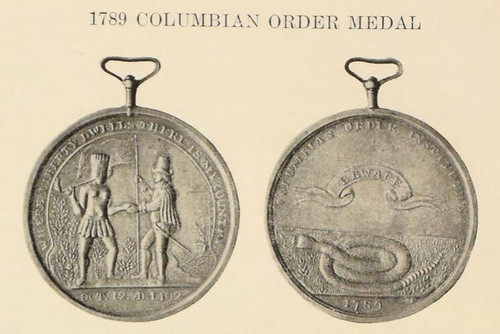
A detail from an illustration of a Tammany Society medal. Columbus and Tammany join hands in friendship, though they lived nearly two centuries apart. Above them is the motto “Where Liberty Dwells, there is my Country.” From the catalogue of the numismatic collections of W. W. C. Wilson (New York: Anderson Galleries, 1925)
To read the complete article, see:
The monument that created Columbus
(https://americanhistory.si.edu/blog/created-columbus)
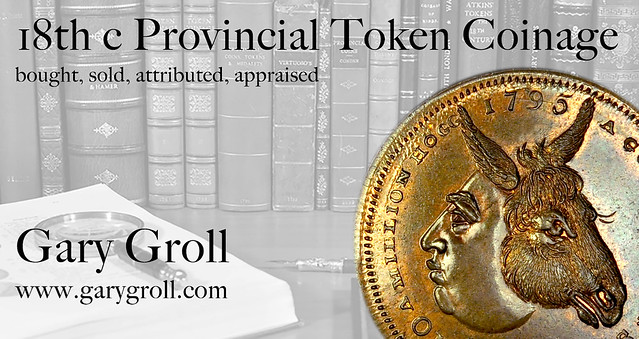
MAURICE STORCK FRACTIONAL GOLD COINS
Jeff Garrett published an article October 8, 2020 on the California fractional gold coins in the Maurice Storck collection. Here's an excerpt. -Editor
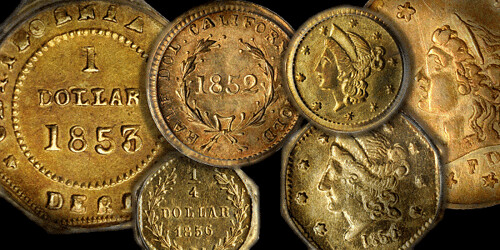
Next week, Heritage Auctions will be offering the Maurice Storck Collection. Storck was a coin dealer who was active starting in the 1950s and famously attended the King Farouk sale that was held in Cairo, Egypt in 1954. When he died last year at the age of 97, he was the last US numismatist who attended that sale in person. His collection contains an interesting array of US rarities and will be warmly received, as are all old-time collections when they enter the marketplace.
While reviewing the catalog, one section was of particular interest to me: over three hundred lots of Californian fractional gold coins. This is a very comprehensive offering and is sure to garner considerable attention from specialized collectors of this series.
California fractional gold coins have always been one of my favorite series. In the 1980s, I assembled a large collection and later sold them, much to my regret today. Maurice Storck, like many coin dealers and collectors of the past, was probably drawn to their relatively low cost and historical significance.
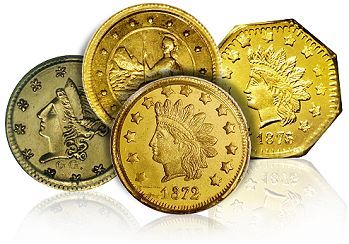 My appreciation for Californian fractional gold coins deepened several years ago when the Odyssey Marine Corporation was excavating the shipwreck site of SS Central America. I was hired to perform a series of appraisals as material was brought up from the seafloor.
My appreciation for Californian fractional gold coins deepened several years ago when the Odyssey Marine Corporation was excavating the shipwreck site of SS Central America. I was hired to perform a series of appraisals as material was brought up from the seafloor.
I had the opportunity to closely examine thousands of wonderful US gold coins. As much as I found them interesting, however, my most fascinating discovery was the presence of quantities of California fractional gold coins. These tiny gold coins clearly circulated during the California Gold Rush. It's hard to believe that something as small as the California gold quarter dollars actually was used as money. The proof was in these Tupperware containers.
Due to the scarcity of smaller denomination coins during the Gold Rush, privately minted quarter, half, and dollar coins were minted starting in 1852. These coins circulated alongside smaller-size silver coins from around the world, many of which were also found on the Central America. The fractional gold coins were lightweight but were still accepted in commerce.
Dozens of private companies minted California fractional gold coins, and there are about 575 different varieties known of all types. The standard reference for the series is California Pioneer Fractional Gold by Walter Breen and Ron Gillio. Coins are assigned BG numbers when attributed.
To read the complete article, see:
Jeff Garrett: Fractional Gold Comes to Market
(https://coinweek.com/us-coins/jeff-garrett-fractional-gold-comes-to-market/)

SAFE DEPOSIT COLONIAL PAPER COLLECTION RETURNED
The loss of a safe deposit box is every collector's nightmare. Here's a story of a lost Colonial paper money collection returned to its thankful owner. Found via News & Notes from the Society of Paper Money Collectors (Volume VI, Number 17, October 13, 2020). -Editor
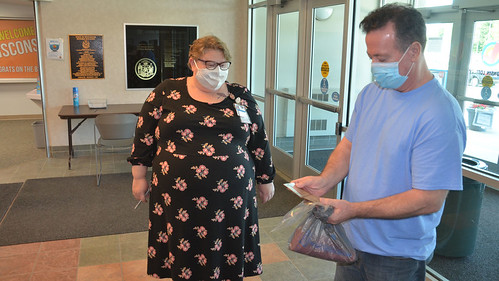
A colonial era currency collection, once thought to be lost, was recently returned to an Appleton man.
Before becoming lost, John Hale held his collection about 10 years ago, according to a Wisconsin Department of Revenue news release.
After years had passed, Hale returned to the bank where he left the collection to check the deposit box with it, but said the bank was no longer there.
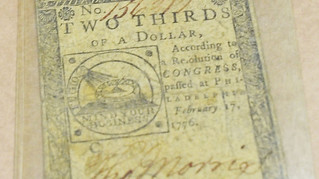 "I didn't know where it was until I got a call," said Hale, referring to a phone call he received last week from the DOR.
"I didn't know where it was until I got a call," said Hale, referring to a phone call he received last week from the DOR.
According to Wisconsin state law, property is considered abandoned if unclaimed by the owner for five years after the lease or rental period expires.
Because Hale's box fit the law, it was turned over to the DOR's unclaimed property section, the release said.
After holding onto the box for three years, the DOR was required to place it up for auction.
Upon examining the box, the DOR found a 1976 Appleton newspaper article, which said that Hale's father received the currency from a friend who served in World War II 30 years earlier.
The bills were found in Connecticut in 1937 and had print dates of either 1776 or 1778.
Also inside the box was a Social Security Number, which was used to track down Hale's phone number, according to the release.
The DOR then contacted Hale, who traveled to Madison to get the collection.
To read the complete article, see:
Appleton man reunited with long-lost colonial era currency collection
(https://fox11online.com/news/offbeat/appleton-man-reunited-with-long-lost-colonial-era-currency-collection)

GREENWOOD BANK FOR UNDERSERVED COMMUNITIES
In earlier issues we discussed Maggie Lena Walker's pioneering St. Luke Penny Savings Bank, founded in Richmond, Va., in 1903. We're getting farther from numismatics here, but it's interesting to follow the evolution of Black banking into the digital age. The Fast Company article looks at a new digital bank aiming to build wealth in Black and Latinx communities. Here's an excerpt - see the complete article online for more. -Editor
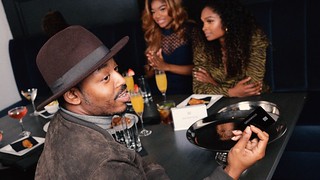 Rapper Michael “Killer Mike” Render has long been an advocate for supporting Black-owned businesses and circulating money within Black-owned banks. Back in 2016, he spearheaded a call to action for financial empowerment that led to other influential rappers moving their money to Black-owned banks, with everyday citizens following suit in droves.
Rapper Michael “Killer Mike” Render has long been an advocate for supporting Black-owned businesses and circulating money within Black-owned banks. Back in 2016, he spearheaded a call to action for financial empowerment that led to other influential rappers moving their money to Black-owned banks, with everyday citizens following suit in droves.
And now Render is taking his mission one step further with Greenwood, a mission-driven digital bank he's cofounded alongside Andrew J. Young, civil rights activist and former Atlanta mayor, and Ryan Glover, the founder and president of Bounce TV.
Named after the historic neighborhood in Tulsa, Oklahoma, that was dubbed Black Wall Street in the early 1900s, Greenwood's mission is to give equitable financial services to Black and Latinx communities while also giving back with charitable initiatives. Eventually, Render hopes Greenwood becomes a valuable addition to the money circulation within marginalized communities.
In order for marginalized groups to attain socioeconomic parity, there have to be banking options that are not only fair, but that keep money circulating within communities of color—all of which was front of mind for Render and his team.
Greenwood is a neobank, which means that it's a digital-only financial institution. Neobanking is becoming increasingly popular: In the U.S. and Europe, there are currently more than two dozen neobanks that have collectively raised more than $6 billion in venture funding. Due to their streamlined banking options and lack of brick-and-mortar locations, neobanks tend to have fewer or no fees attached to their services—and Greenwood is no different. At launch, it will offer savings and spending accounts, debit cards, Apple and Android pay, peer-to-peer money transfers, mobile deposits, and ATM accessibility, with no hidden fees.
“The alternative has been check cashing places in our communities, as they've become banking deserts.”
To read the complete article, see:
Killer Mike's new digital bank aims to build wealth in Black and Latinx communities
(https://www.fastcompany.com/90561560/killer-mike-greenwood-black-neobank)
To read the earlier E-Sylum articles, see:
MAGGIE LENA WALKER'S SAVINGS BANK
(https://www.coinbooks.org/v23/esylum_v23n40a30.html)
LOOSE CHANGE: OCTOBER 11, 2020 : The St. Luke Finance Corporation in the 1920s
(https://www.coinbooks.org/v23/esylum_v23n41a32.html)
THE BOOK BAZARRE
LOOSE CHANGE: OCTOBER 18, 2020
Here are some additional items in the media this week that may be of interest. -Editor
Is your coin really as valuable as Google tells you?
The Australian Coin Collecting Blog published a nice article bursting the bubble of those who get sucked in by clickbait headlines about high prices for the coin they want to sell for the big bucks. -Editor
If you think you might have a valuable coin then it's worth doing your own due diligence which is more than reading the title on a search result. Read thoroughly or watch the video to ensure you are getting truth. Then don't just check asking prices, see what your coin is actually selling for in the marketplace right now (check sold results on eBay). First check that the information is about your coin. Does it have the same mintmark, is it an error or variety -check the details on how to identify accurately, is it the correct year, the correct country, denomination, is it the finest known example of that coin, was it produced in low numbers for that year or only in sets -there are so many small details that can affect the value of a coin.
To read the complete article, see:
Googled the Value of My Coin and it's Worth Thousands -Where Do I Get The Money?
(https://www.australian-coins.com/collecting-coins/googled-the-value-of-my-coin-and-its-worth-thousands-where-do-i-get-the-money/)
American Eagle Silver Bullion Mintage
Kudos to Lee Minshull for his success in using a Freedom of Information Act (FOIA) request to confirm information about the mintage of American Eagle silver bullion coins, as noted in this Coin World article. -Editor
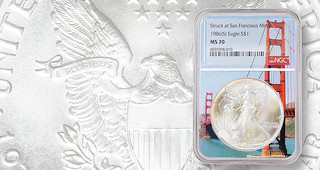 Coin World's Coin Values price guide has long listed the San Francisco Mint as the sole source (accurately) for American Eagle silver bullion coin production for those two years. However, published information from other sources previously identified that 1986 and 1987 production from the first two years of the series also included coins from the West Point and Denver Mint facilities.
Coin World's Coin Values price guide has long listed the San Francisco Mint as the sole source (accurately) for American Eagle silver bullion coin production for those two years. However, published information from other sources previously identified that 1986 and 1987 production from the first two years of the series also included coins from the West Point and Denver Mint facilities.
Lee Minshull from Lee Minshull Rare Coins Inc. in Palos Verdes, California, submitted the FOIA inquiry seeking clarification of the mintage information. The charted information provided by the Mint, which Minshull shared with Coin World, in response to that request details the mintage numbers and production information from 1986 through July 17, 2017.
To read the complete article, see:
Mint FOIA response confirms origins of American Eagles
(https://www.coinworld.com/news/us-coins/mint-foia-response-confirms-origins-of-american-eagles)
Virus Survival on Banknotes
Bob Leuver passed along this article from The Guardian about a new study about the life of viruses on banknotes. Thanks. -Editor
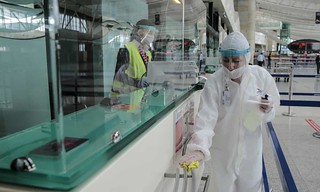 Australian scientists have found that the virus that causes Covid-19 can survive for up to 28 days on surfaces such as the glass on mobile phones, stainless steel, vinyl and paper banknotes.
Australian scientists have found that the virus that causes Covid-19 can survive for up to 28 days on surfaces such as the glass on mobile phones, stainless steel, vinyl and paper banknotes.
The national science agency, the CSIRO, said the research undertaken at the Australian Centre for Disease Preparedness (ACDP) in Geelong also found that Sars-CoV-2 survived longer at lower temperatures.
It said in a statement the virus survived longer on paper banknotes than on plastic banknotes and lasted longer on smooth surfaces rather than porous surfaces such as cotton.
To read the complete article, see:
Virus that causes Covid-19 can survive up to 28 days on surfaces, scientists find
(https://www.theguardian.com/world/2020/oct/12/virus-that-causes-covid-19-can-survive-up-to-28-days-on-surfaces-scientists-find)
The Dawn of the Reverse ATM
Coronavirus concerns are partly behind the creation of a new feature for Automated Teller Machines (ATMs). -Editor
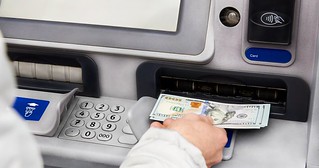 With cash a concern to pandemic-wary consumers and merchants payments firms, a new ATM option, called the "reverse ATM," has gained attention in the ATM industry. The machine takes in cash instead of dispensing it, allowing users to convert paper money into an electronic payment. A Toronto-based company, XTM Inc., has deployed a machine at Scotia Bank Arena in Toronto as part of a pilot program, according to a report in Digital Transactions.
With cash a concern to pandemic-wary consumers and merchants payments firms, a new ATM option, called the "reverse ATM," has gained attention in the ATM industry. The machine takes in cash instead of dispensing it, allowing users to convert paper money into an electronic payment. A Toronto-based company, XTM Inc., has deployed a machine at Scotia Bank Arena in Toronto as part of a pilot program, according to a report in Digital Transactions.
The XTM machine activates and dispenses an open-loop, prepaid Mastercard-branded card loaded with the value represented by cash inserted by the user. The cards dispensed by the machines, which feature a 42-inch touchscreen, are EMV- and contactless-enabled, and can be dispensed within a minute after the user inserts his bills.
XTM has three more machines on order for the stadium, which hosts games for the Toronto Raptors National Basketball Association team and the Toronto Maple Leafs National Hockey League.
To read the complete article, see:
Toronto stadium pilots a 'reverse ATM'
(https://www.atmmarketplace.com/news/toronto-stadium-pilots-a-reverse-atm/)
The Astronomicum Caesareum of Petrus Apianus
Totally non-numismatic, but here's a Heritage lot our bibliophiles should appreciate. Mike Marotta passed this along. Thanks. -Editor
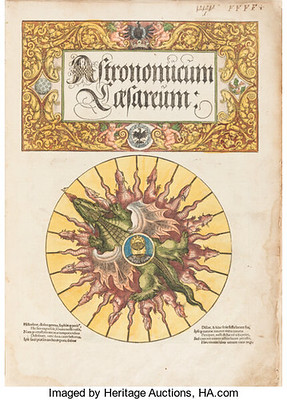 "The most spectacular contribution of the book-maker's art to sixteenth-century science was without doubt the Astronomicum Caesareum of Petrus Apianus. Designed for Charles V and his brother Ferdinand, the volume was in every way a luxurious and princely production. Its pages were large, brilliantly hand-coloured, and filled with ingeniously contrived mechanisms, sometimes with five or even six layers of paper disks, arranged to give planetary positions plus a variety of calendarial and astrological data. Published in 1540 at Apianus's private press in Ingolstadt, the book graphically displayed Ptolemaic astronomy in a fashion fit for a monarch's eyes" (Owen Gingerich, "Apianus's Astronomicum Caesareum and Its Leipzig Facsimile," in Journal for the History of Astronomy 2 (1971), pp. 168-177).
"The most spectacular contribution of the book-maker's art to sixteenth-century science was without doubt the Astronomicum Caesareum of Petrus Apianus. Designed for Charles V and his brother Ferdinand, the volume was in every way a luxurious and princely production. Its pages were large, brilliantly hand-coloured, and filled with ingeniously contrived mechanisms, sometimes with five or even six layers of paper disks, arranged to give planetary positions plus a variety of calendarial and astrological data. Published in 1540 at Apianus's private press in Ingolstadt, the book graphically displayed Ptolemaic astronomy in a fashion fit for a monarch's eyes" (Owen Gingerich, "Apianus's Astronomicum Caesareum and Its Leipzig Facsimile," in Journal for the History of Astronomy 2 (1971), pp. 168-177).
In his 1995 survey of the Astronomicum Caesareum, Gingerich accounts for 111 copies and estimates that there are probably fewer than another twenty-five copies he did not personally examine [the present copy is among those unseen by OG]. Of all the copies inspected by Gingerich, perhaps fewer than ten percent were regarded by him as complete or nearly complete. Our copy has thirty-six full-page plates of woodcut astronomical figures (the figure on G3 verso is also used on the title-page), within frames that resemble astrolabes, with six different patterns of handles, of which twenty-one have a total of sixty volvelles. There are twenty-nine original silk threads and eight tiny seed pearls (measuring 1 mm.), used as sliding indicators. Of the more than one hundred known copies of the Astronomicum Caesareum, numerous are textually incomplete (i.e. lacking some of the fifty-nine printed leaves). Our copy is textually complete, while wanting some of the volvelles, threads, and seed pearls that Gingerich suggests would make up a complete copy.
Mike adds:
"I found it written about at the National Library of Scotland
https://blog.nls.uk/astronomicum-caesareum/
and the University of Chicago Library
https://www.lib.uchicago.edu/collex/exhibits/they-saw-stars-art-and-
astronomy/early-representations/astronomicum-caesareum/
and the Metropolitan Museum
https://www.metmuseum.org/art/collection/search/337061
"Like so many antiquities, this rare book seldom passes into the hands of private collectors. This copy sold for $325,000 including the buyer's fees."
To read the complete lot description, see:
[Petrus Apianus]. Astronomicum Caesareum. [Ingolstadt: In aedibus nostris, May 1540]. First edition of the "most..
(https://historical.ha.com/itm/books/-petrus-apianus-astronomicum-caesareum-ingolstadt-in-aedibus-nostris-may-1540-first-edition-of-the-most/a/6230-45195.s)

THE LAST BOOKSTORE
Bibliophiles and numismatists alike ought to enjoy browsing in this L.A. bookstore housed in a former bank building. -Editor
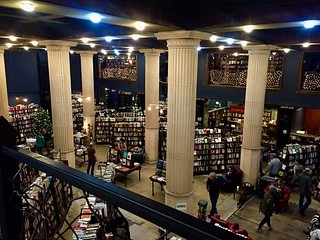 MORE THAN A FEW BIBLIOPHILES would prefer that their prized possessions be kept in a bank vault as opposed to a bookshelf, but few actually get to see their dream in action. Enter The Last Bookstore, an iconic Los Angeles book shop with a not-so-subtly symbolic name that is housed in the grand atrium of what was once a bank.
MORE THAN A FEW BIBLIOPHILES would prefer that their prized possessions be kept in a bank vault as opposed to a bookshelf, but few actually get to see their dream in action. Enter The Last Bookstore, an iconic Los Angeles book shop with a not-so-subtly symbolic name that is housed in the grand atrium of what was once a bank.
The marble pillars and mile-high ceiling remain from the old bank, but in place of patrons and guarded stacks of cash, bookshelves line the walls and artful displays of books abound.
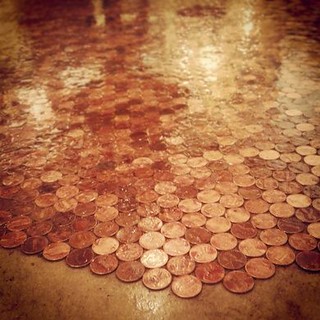 Not to imply that everything is brand new and sparkly. The bookstore actually specializes in reasonably priced used books, and takes great pride in offering a selection of well-kept vintage books as well. Anyone who's ever loved a vintage book will know exactly what that means for the musty, decadent smell that hangs in the air in this seemingly sacred place.
Not to imply that everything is brand new and sparkly. The bookstore actually specializes in reasonably priced used books, and takes great pride in offering a selection of well-kept vintage books as well. Anyone who's ever loved a vintage book will know exactly what that means for the musty, decadent smell that hangs in the air in this seemingly sacred place.
Almost as if to make a point about beauty in disarray, the bookshelves are placed every which way all throughout the store, and sculptures have been custom-built from overstocked or damaged copies. There are even hidden nooks, like the old bank vault itself, where books are winkingly displayed.
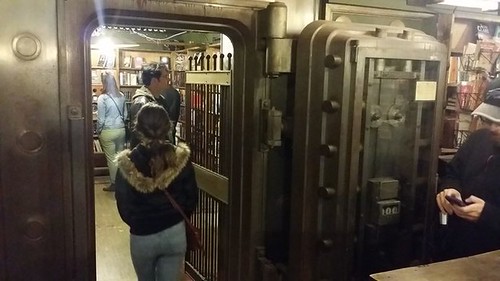
This just popped onto my radar this week, but I think the article was published a few years ago. It's still there and open for business! -Editor
For more information, see:
http://lastbookstorela.com/
To read the complete article, see:
The Last Bookstore
(https://www.atlasobscura.com/places/last-bookstore)
GOLD SMUGGLER CAUGHT AT INDIAN AIRPORT
Dick Hanscom "passed" along this story an a funny-walking smuggler caught hiding gold in an awkward place. -Editor
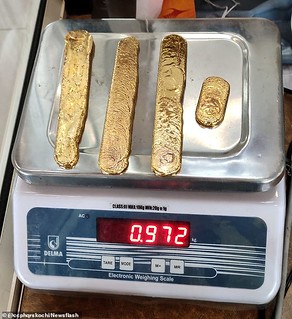 A smuggler was caught with 2lb of gold worth £46,000 in his bottom after customs officers spotted his unusual walk at an airport in India.
A smuggler was caught with 2lb of gold worth £46,000 in his bottom after customs officers spotted his unusual walk at an airport in India.
The man was travelling on a GoAir flight from Dubai into Kerala's Kannur airport and had hidden the stash of gold inside his own body to avoid paying the 18 per cent tax.
It is believed he had been walking awkwardly and was stopped and checked as a result where the gold was discovered by officials from the Air Intelligence Unit (AIU), who also shared images of the precious metal which had been recovered.
Police said another man on the same flight was stopped from trafficking 3.2lb (1.47kg) of gold into India.
However, they did not reveal how he concealed the precious metal, The National reported.
They were the latest in a number of seizures of gold being smuggled into the country from Arabic states.
To read the complete article, see:
Man with the golden bum: Smuggler is caught with 2lb of gold worth $60,000 in his backside after customs officers spotted his unusual walk at Indian airport
(https://www.dailymail.co.uk/news/article-8844123/Smuggler-caught-2lb-gold-worth-46-000-backside-Indian-airport.html)

